Siemens RF600R RFID UHF Reader User Manual SIMATIC RF600
Siemens AG RFID UHF Reader SIMATIC RF600
Siemens >
Contents
- 1. User manual 01
- 2. User manual 02
- 3. User manual 03
- 4. User manual 04
- 5. User manual 05
User manual 05
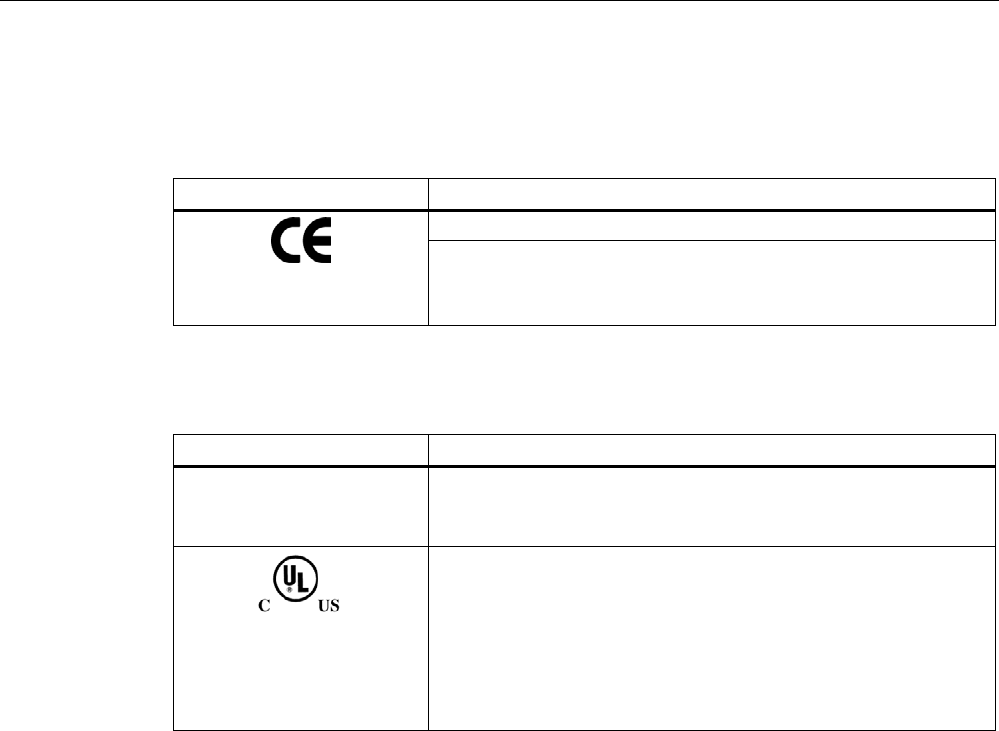
Transponder/tags
7.8 SIMATIC RF640T Gen 2
SIMATIC RF600
System Manual, 05/2012, J31069-D0171-U001-A13-7618 359
7.8.7 Certificates and approvals
Table 7- 25 6GT2810-2DC00 - RF640T Gen 2 UHF Tool Tag - Europe
Certificate Description
CE approval according to R&TTE guideline
For Directive 94/9/EC:
EC type test certification no. TÜV 07 ATEX 346241
Acknowledgement of the quality assurance TÜV 96 ATEX 1125 Q
Table 7- 26 6GT2810-2DC10 - RF640T Gen 2 UHF Tool Tag - USA/Canada
Standard
FCC
Federal Communications
Commission
Passive labels or transponders comply with the valid regulations;
certification is not required
This product is UL-certified for the USA and Canada.
It meets the following safety standard(s):
UL 60950-1 - Information Technology Equipment Safety - Part 1:
General Requirements
CSA C22.2 No. 60950 -1 - Safety of Information Technology
Equipment
UL Report E 205089
7.8.7.1 Manufacturer's declaration RF640T Gen 2 UHF Tool Tag Version 1
The plant that manufactured the RF640T Gen 2 UHF Tool Tag Version 1 has an ATEX
quality assurance system recognized by TÜV NORD with notification number
TÜV 96 ATEX 1125 Q. The type test certification for the
RF640T Gen 2 UHF Tool Tag Version 1 is stored by TÜV 07 ATEX 346241.
Manufacturer's address
Siemens AG
Automation and Drives
System Engineering A&D SE
Würzburger Strasse 121
90766 Fürth, Germany.
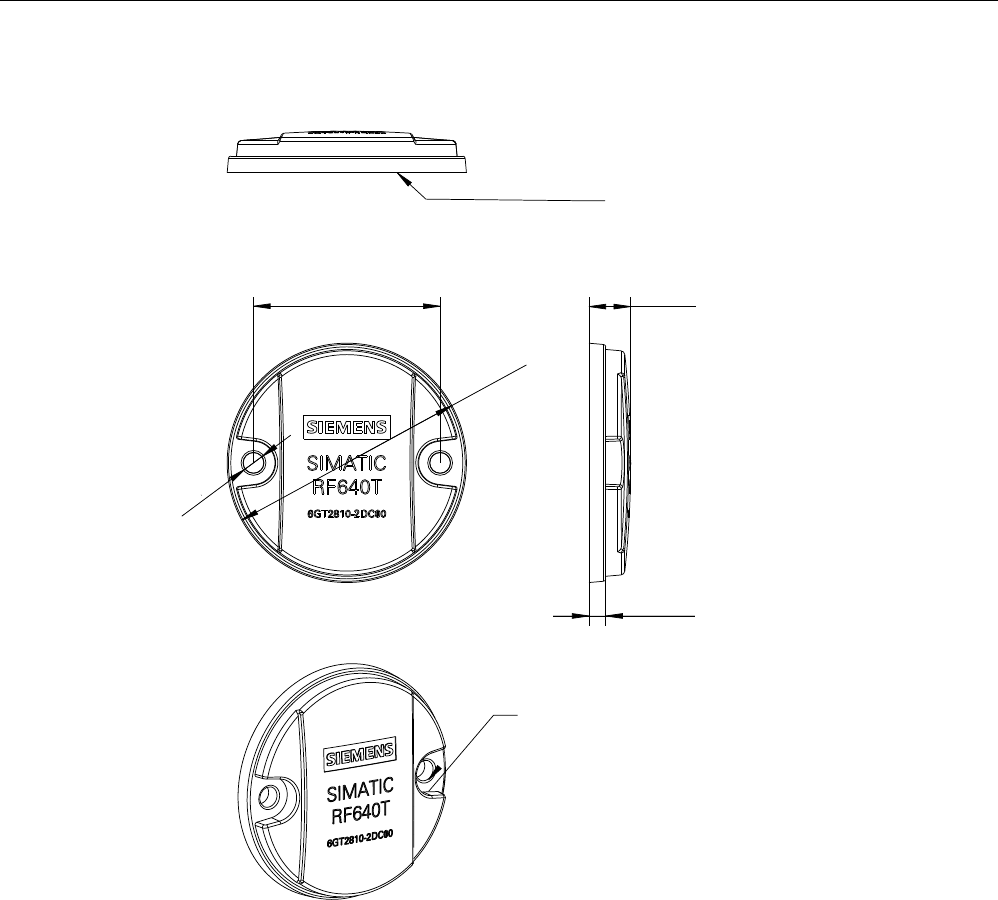
Transponder/tags
7.8 SIMATIC RF640T Gen 2
SIMATIC RF600
360 System Manual, 05/2012, J31069-D0171-U001-A13-7618
7.8.8 Dimension drawing
',1ZDVKHUV
F\OLQGHUKHDGVFUHZVZLWK
KH[DJRQDOVRFNHWKHDG',10
0RXQWLQJVXUIDFH
QHHGVWREHIODW
Figure 7-46 SIMATIC RF640T Gen 2 UHF Tool Tag Version 1
Units of measurement: All dimensions in mm
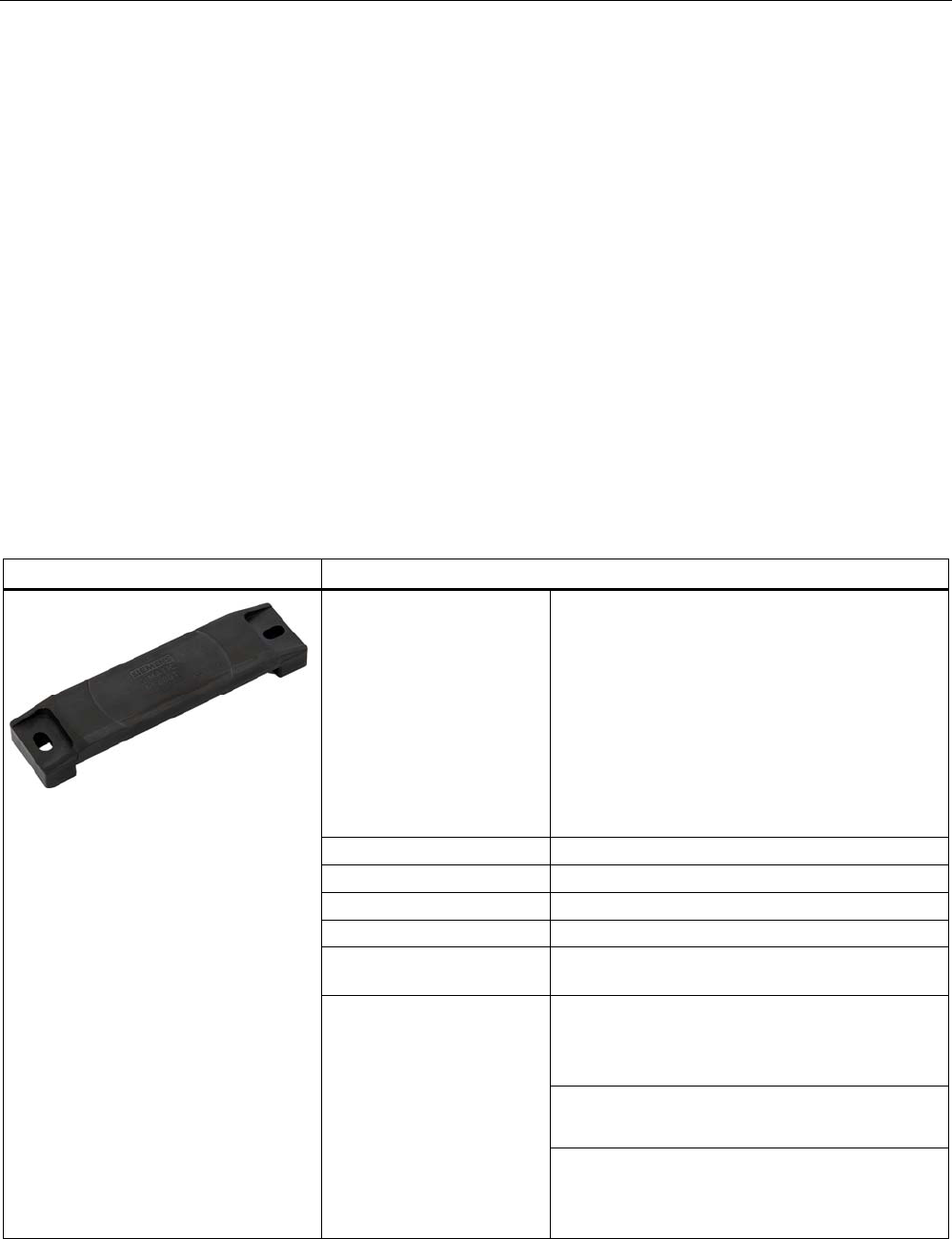
Transponder/tags
7.9 SIMATIC RF680T
SIMATIC RF600
System Manual, 05/2012, J31069-D0171-U001-A13-7618 361
7.9 SIMATIC RF680T
7.9.1 Characteristics
The heat-resistant SIMATIC RF680T transponder is a passive, maintenance-free data
carrier. It operates based on the UHF Class 1 Gen 2 technology and is used to save the
"Electronic Product Code" (EPC) of 96 bits/240 bits. The transponder also has a 512-bit user
memory.
These transponders with limited service life are ideally suited to high-temperature
applications
(e.g. the painting of vehicle bodies) as well as applications in production logistics.
The RF680T is rugged and suitable for industrial applications with IP68/IPX9K degree of
protection.
It is highly resistant to oil, grease and cleaning agents.
The SIMATIC RF680T is mounted directly onto metal and non-metal carrier plates to ensure
optimal operation and has a typical detection range of 4 m.
SIMATIC RF680T transponder Features
Application Applications with high temperatures (up to +220
°C)
Typical application areas:
• Paint shops and their preparatory treatments,
incl. drying ovens
• Electrophoretic deposition area
• Primer coat incl. drying oven
• Top coat area incl. drying oven
• Washing areas at temperatures > 85 °C
Frequency range 865 ... 928 MHz (ETSI and FCC)
Air interface according to ISO°18000-6C
Polarization Linear
Temperature range up to 220 °C
Memory EPC 96 bit/240 bit
Add-on-memory 64 bytes
typically 3 m in conjunction with:
• RF640R/RF670R reader and
• RF660A antenna
typically 3.6 m in conjunction with:
• RF640R with integrated antenna
Reading / writing range
Typically 1.4 m/2 m in connection with:
• RF620R/RF630R reader and
• RF660A antenna
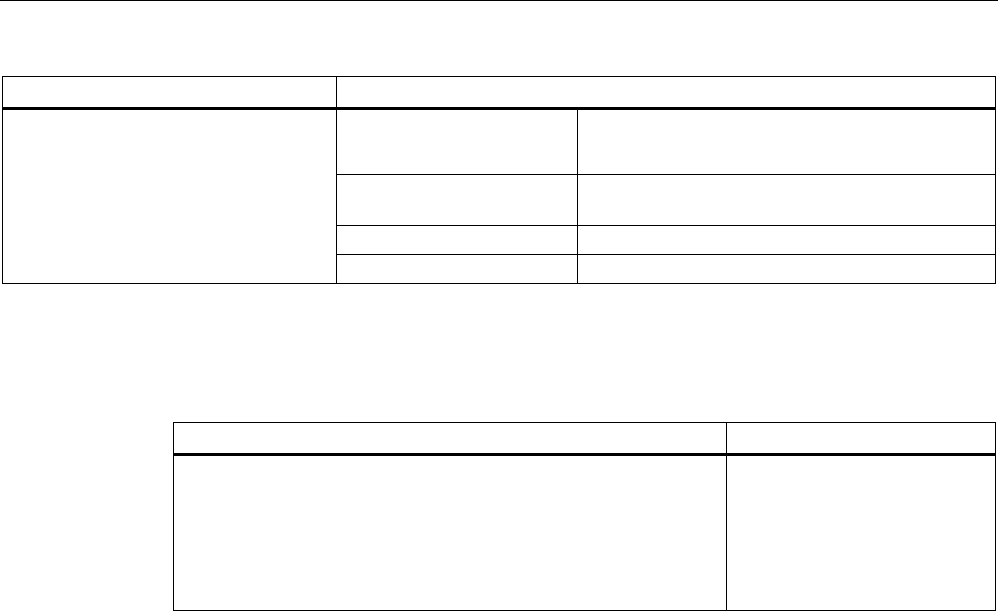
Transponder/tags
7.9 SIMATIC RF680T
SIMATIC RF600
362 System Manual, 05/2012, J31069-D0171-U001-A13-7618
SIMATIC RF680T transponder Features
Typically 1.4 m/2 m in connection with:
• RF620R with integrated antenna
Installation Suitable for direct mounting on conductive and
non-conductive materials.
Material Plastic PPS; silicone-free
Dimensions 130 x 32 x 15 mm
7.9.2 Ordering data
Ordering data Order no.
SIMATIC RF680T
• Frequency 865 MHz to 928 MHz
• EPC 96 bit/240 bit (64 bytes user memory)
• -25 ... +220 °C
• 130 x 32 x 15 mm
6GT2810-2HG80
7.9.3 Planning the use
The absolute values of the reading ranges specified below refer to a transmit power of
2 W ERP.
When the power is reduced (e.g. when a different reader is used), you will find the
corresponding reduced reading ranges in the following table:
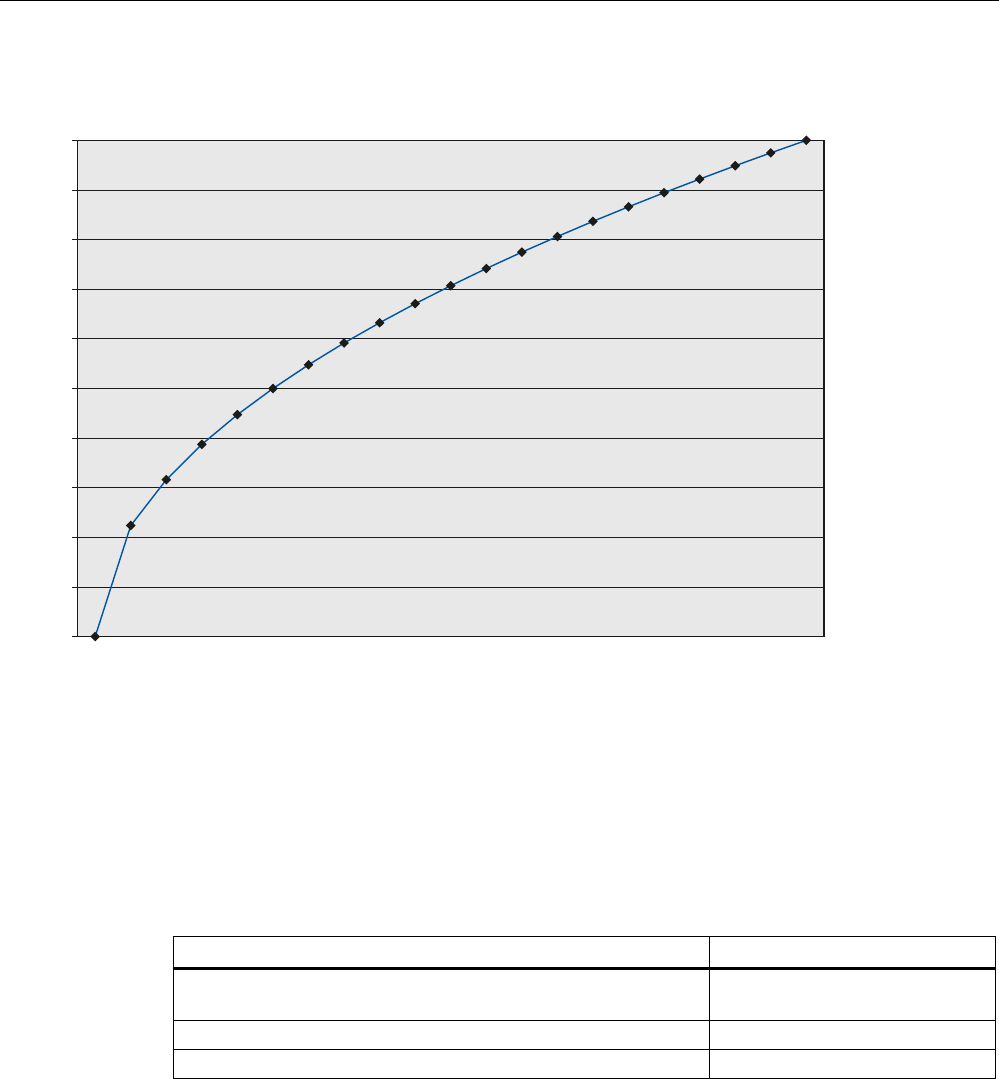
Transponder/tags
7.9 SIMATIC RF680T
SIMATIC RF600
System Manual, 05/2012, J31069-D0171-U001-A13-7618 363
5HDGLQJUDQJHSHUFHQWDJH
5DGLDQWSRZHUP:b(53
5HODWLRQVKLSEHWZHHQUDGLDQWSRZHUDQGUHDGLQJUDQJH
7.9.3.1 Reading range when mounted on non-metallic carriers
The RF680T transponder is a universal transponder for mounting on many different types of
carrier plate materials.
Table 7- 27 Reading range for non-metal carriers (RF670R = 2 W ERP;)
Carrier plate material Reading range for RF670R
Transponder on wooden carrier
(dry, degree of moisture < 15%)
Typ. 4 m
Transponder on plastic carrier Typ. 4 m
Transponder on glass Typ. 4 m
100% reading range is achieved when mounted in empty, anechoic rooms.
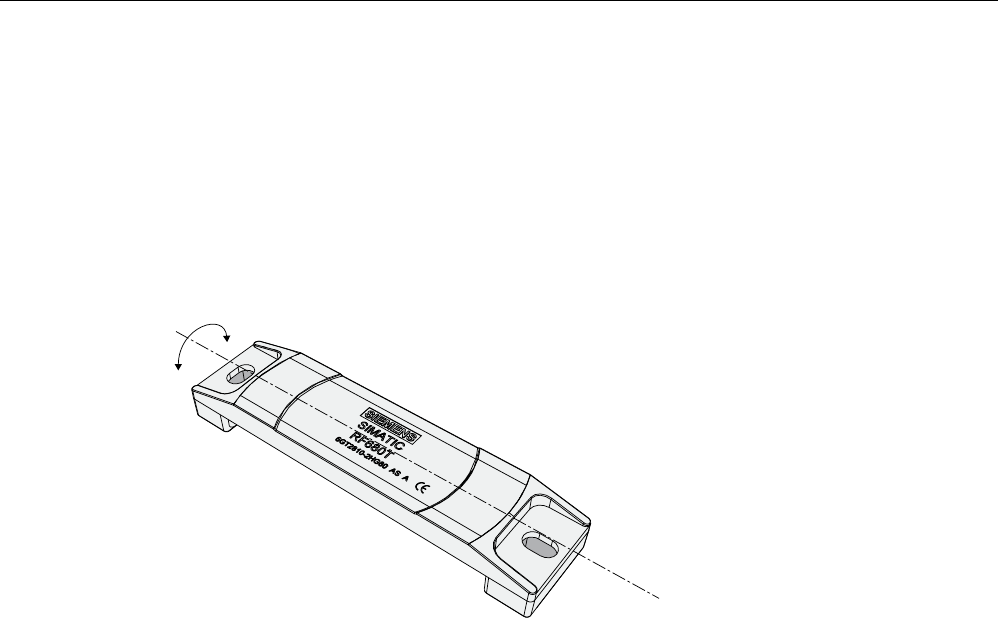
Transponder/tags
7.9 SIMATIC RF680T
SIMATIC RF600
364 System Manual, 05/2012, J31069-D0171-U001-A13-7618
7.9.3.2 Directional radiation pattern of the transponder on non-metallic surfaces
It is recommendable to align the transponder parallel to the transmitting antenna. If,
however, the transponder including the metallic carrier plate is tilted, the reading range will
be reduced.
Rotation about the polarization axis
3RODUL]DWLRQD[LV
Figure 7-47 Rotation of the transponder about the polarization axis
Generally the range does not change when the transponder without carrier material is
rotated about the polarization axis.

Transponder/tags
7.9 SIMATIC RF680T
SIMATIC RF600
System Manual, 05/2012, J31069-D0171-U001-A13-7618 365
Rotation orthogonal to the polarization axis
0
10
20
30
40
50
60
70
80
90
100
-180 -160 -140 -120 -100 -80 -60 -40 -20 0 20 40 60 80 100 120 140 160 180
$QJOHGHJUHHV
5DQJH
Figure 7-48 Transponder characteristics when rotated orthogonally to the polarization axis (within the
tag plane)
If the transponder is positioned orthogonally to the transmitting antenna, it normally cannot
be read. Therefore the transponder is preferably to be aligned parallel to the transmitting
antenna. The following figure illustrates this situation.
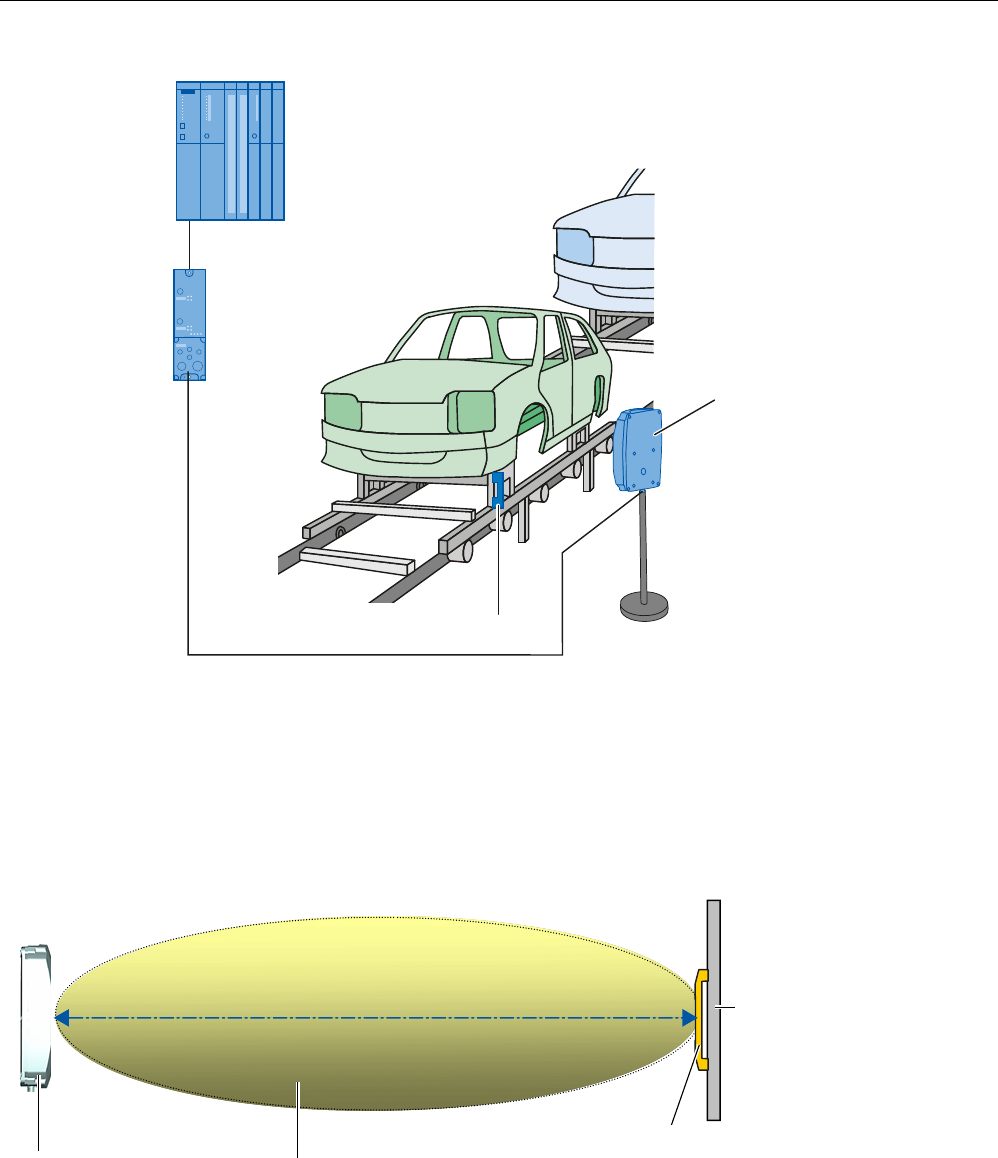
Transponder/tags
7.9 SIMATIC RF680T
SIMATIC RF600
366 System Manual, 05/2012, J31069-D0171-U001-A13-7618
6,0$7,&6
FRQWUROOHU
$60
5HDGHU5)5
7DJ5)7
Figure 7-49 Application example
7.9.3.3 Optimum antenna/transponder positioning with plane mounting of the transponder on
metal
5)7
WUDQVSRQGHU
0HWDOFDUULHU
5)5 $QWHQQDILHOG
5HDGZULWHGLVWDQFHVHHWHFKQLFDOVSHFLILFDWLRQV
7UDQVPLWDQGUHFHLYH
Figure 7-50 Example of optimum antenna/transponder positioning
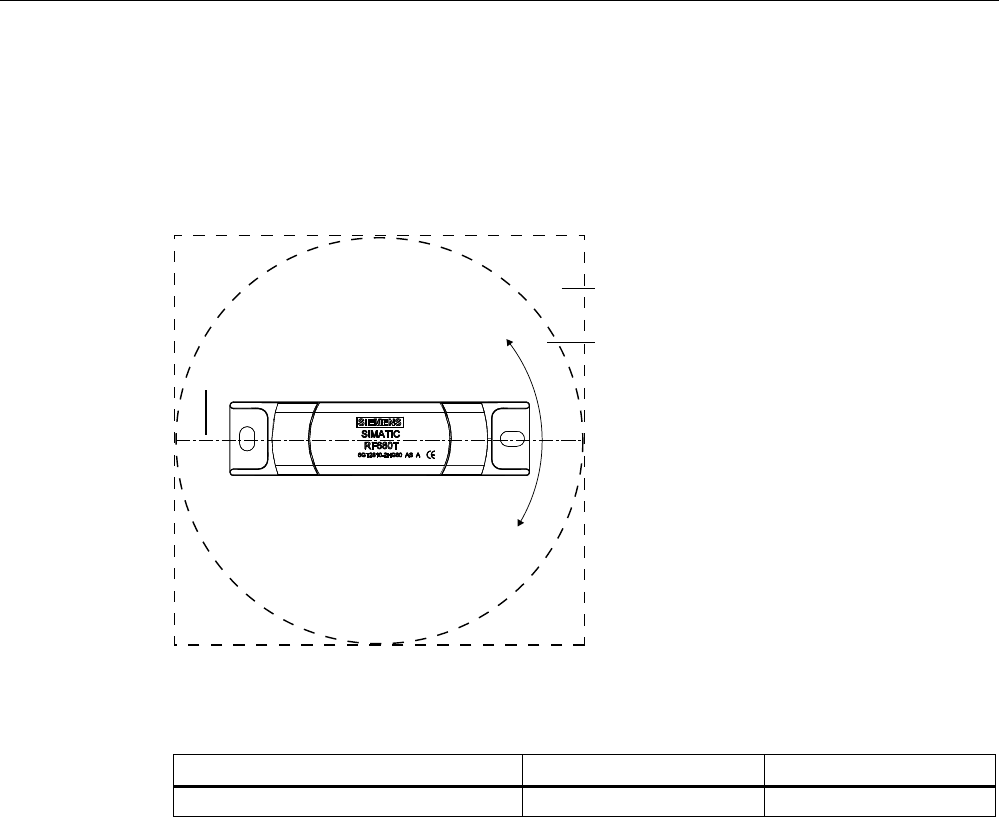
Transponder/tags
7.9 SIMATIC RF680T
SIMATIC RF600
System Manual, 05/2012, J31069-D0171-U001-A13-7618 367
7.9.3.4 Reading range when mounted on plane metallic carrier plates
The transponder generally has linear polarization. The polarization axis runs as shown in the
diagram below. If the transponder is centrally mounted on a plane metal plate, which may
either be almost square or circular, it can be aligned in any direction if the transmitting and
receiving antennas operate with circular polarization (such as RF660A and RF620R).
3RODUL]DWLRQD[LV
6TXDUH
0HWDOFDUULHU
&LUFXODUPHWDO
FDUULHUSODWH
r
Figure 7-51 Optimum positioning of the transponder on a (square or circular) metallic carrier plate
Table 7- 28 Reading range with metallic, plane carriers with spacer
Carrier plate material Reading range Europe Reading range USA
Metal plate 150 x 150 mm Typ. 4 m Typ. 4 m
On rectangular carrier plates, the reading distance depends on the mounting orientation of
the transponder A 90° rotation of the transponder about the axis of symmetry may result in
greater reading distances
7.9.3.5 Influence of conducting walls on the reading range
If there are conducting walls or restrictions in the vicinity that shade the radio field, a distance
of approx. 10 cm is recommended between the transponder and the wall. In principle, walls
have least influence if the polarization axis is orthogonal to the conducting wall.
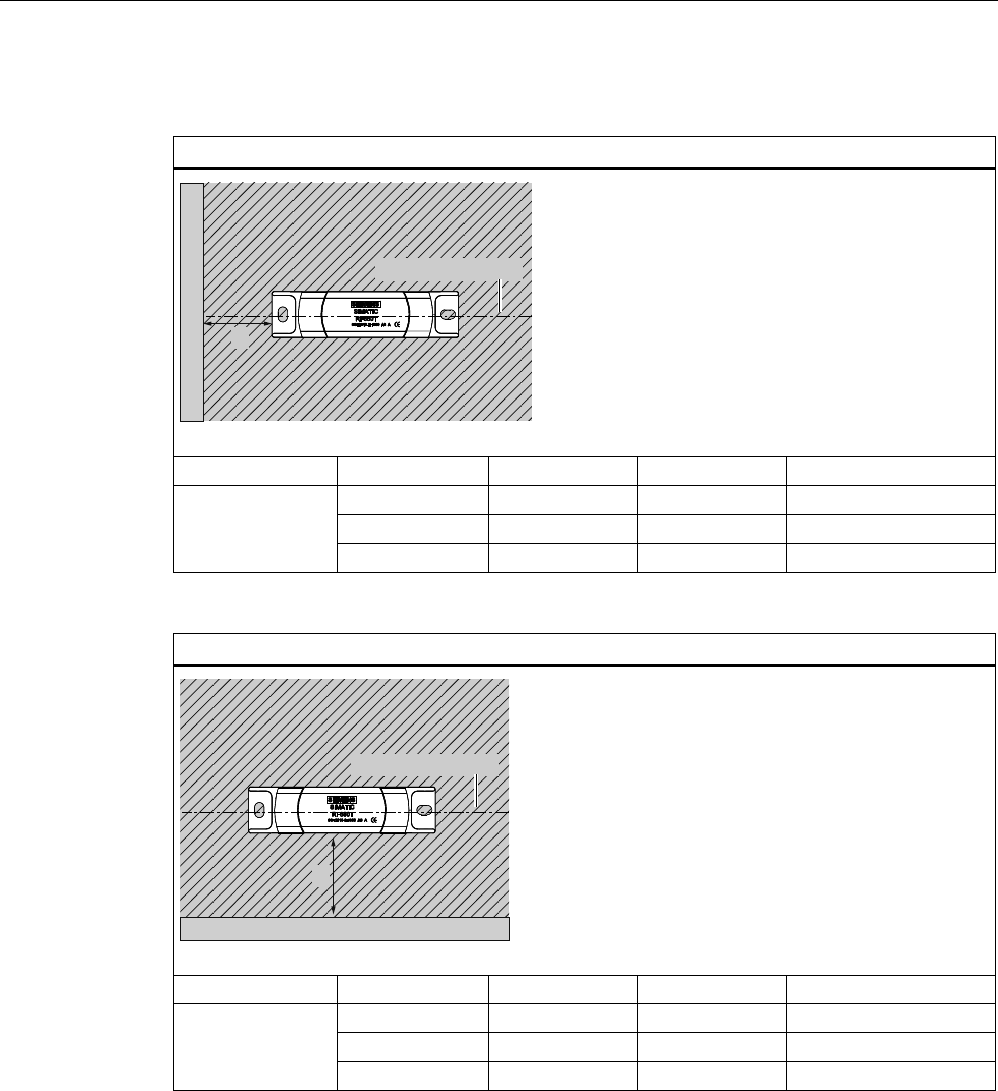
Transponder/tags
7.9 SIMATIC RF680T
SIMATIC RF600
368 System Manual, 05/2012, J31069-D0171-U001-A13-7618
Reading range: One conducting wall
Influence on reading range when positioned orthogonally to the conducting wall
G
&RQGXFWLQJZDOO
3RODUL]DWLRQD[LV
Top view
Distance d 20 mm 50 mm 100 mm
Approx. 100% Approx. 100% Approx. 100% Wall height 20 mm
Approx. 100% Approx. 100% Approx. 100% Wall height 50 mm
Reading range
Approx. 80% Approx. 100% Approx. 100% Wall height 100 mm
Influence on reading range when positioned parallel to the conducting wall
G
&RQGXFWLQJZDOO
3RODUL]DWLRQD[LV
Top view
Distance d 20 mm 50 mm 100 mm
Approx. 50% Approx. 70% Approx. 90% Wall height 20 mm
Approx. 40% Approx. 70% Approx. 90% Wall height 50 mm
Reading range
Approx. 30% Approx. 50% Approx. 90% Wall height 100 mm
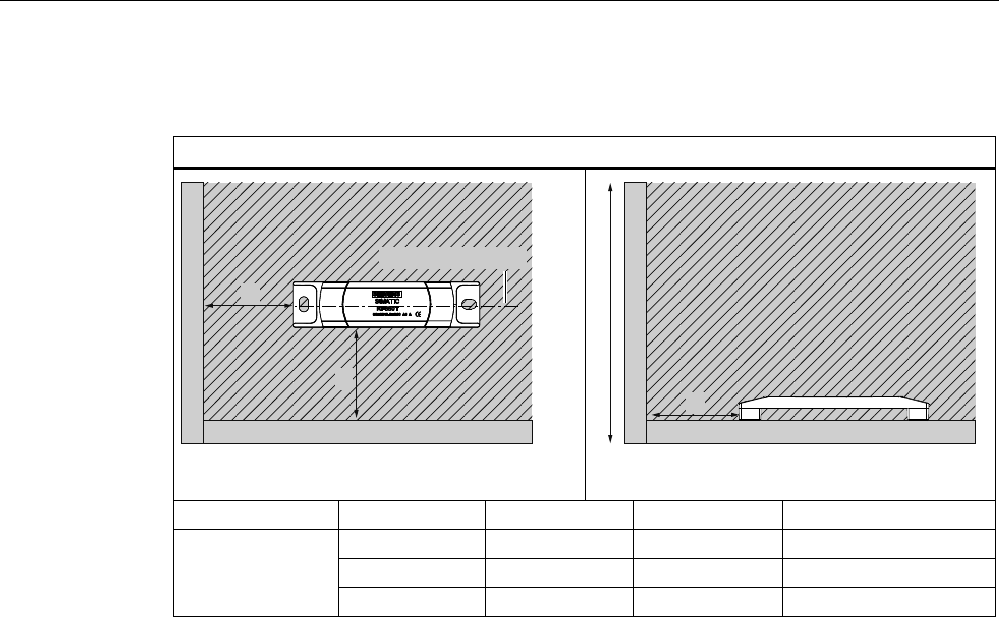
Transponder/tags
7.9 SIMATIC RF680T
SIMATIC RF600
System Manual, 05/2012, J31069-D0171-U001-A13-7618 369
Reading range: Two conducting walls
Influence on reading range when positioned against two conducting walls
G
G
&RQGXFWLQJZDOO
&RQGXFWLQJZDOO
3RODUL]DWLRQD[LV
G
&RQGXFWLQJZDOO
&RQGXFWLQJZDOO
:DOOKHLJKW
Side view
Distance d 20 mm 50 mm 100 mm
Approx. 50% Approx. 70% Approx. 90% Wall height 20 mm
Approx. 30% Approx. 60% Approx. 90% Wall height 50 mm
Reading range
Approx. 25% Approx. 50% Approx. 90% Wall height 100 mm
The values specified in the tables above are reference values.
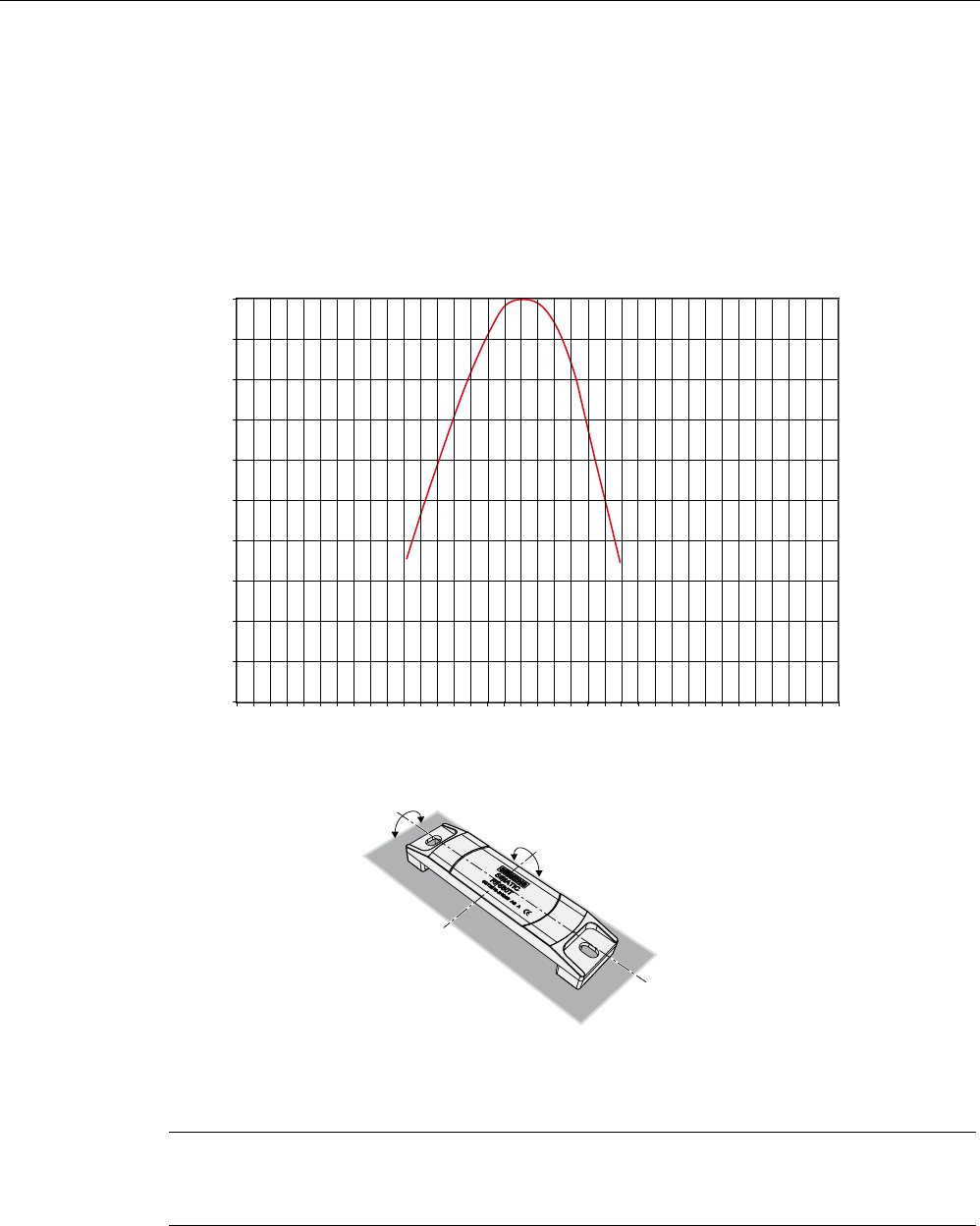
Transponder/tags
7.9 SIMATIC RF680T
SIMATIC RF600
370 System Manual, 05/2012, J31069-D0171-U001-A13-7618
7.9.3.6 Directional radiation pattern of the transponder on metallic surfaces
It is recommendable to align the transponder parallel to the transmitting antenna. If,
however, the transponder including the metallic carrier plate is tilted, the reading range will
be reduced.
Rotation about the polarization axis or orthogonal to the polarization axis
0
10
20
30
40
50
60
70
80
90
100
-170
-150
-130
-110
-90
-70
-50
-30
-10
10
30
50
70
90
110
130
150
170
Figure 7-52 Characteristic of the transponder when rotated about the polarization axis or orthogonally
to the polarization axis
Note
Please note that the directional effect is dependent on the size of the metal surface. The
larger the metal surface, the larger the directional effect.
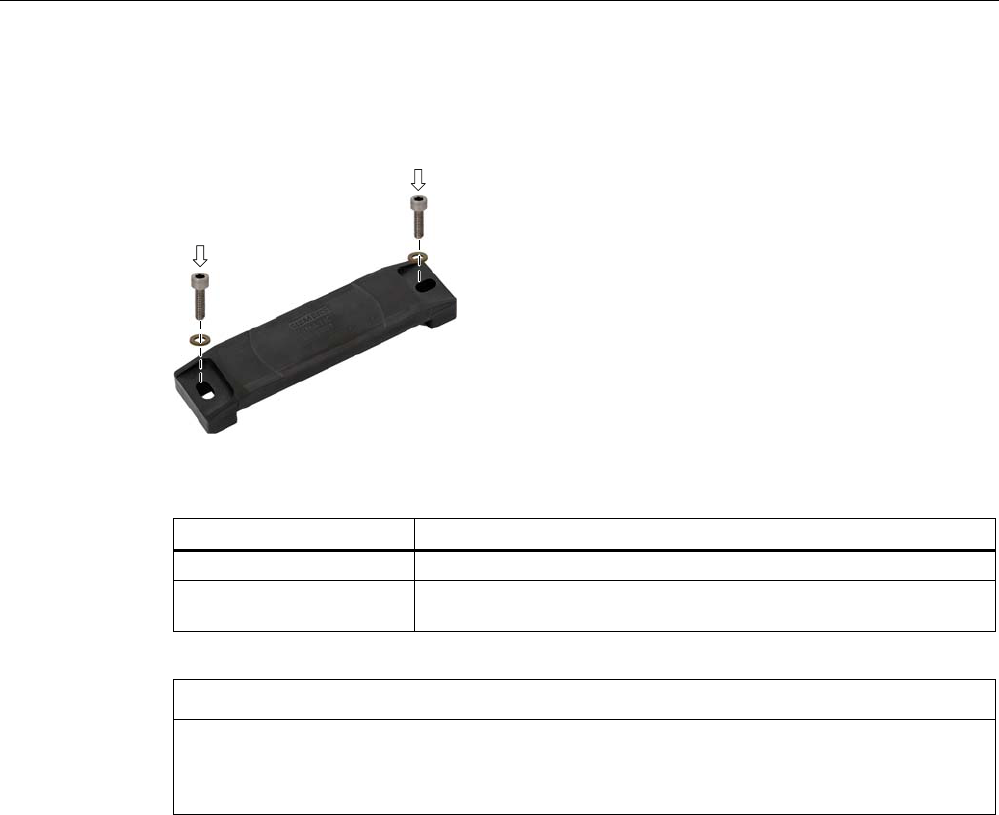
Transponder/tags
7.9 SIMATIC RF680T
SIMATIC RF600
System Manual, 05/2012, J31069-D0171-U001-A13-7618 371
7.9.4 Mounting instructions
Mount the SIMATIC RF680T transponder on the base using two M6 screws.
Figure 7-53 Mounting SIMATIC RF680T
Properties Description
Type of mounting M6 screw mounting
Tightening torque
(at room temperature)
≤ 1 Nm (Note the expansion coefficients of the materials used at high
temperatures!)
NOTICE
Reduction of the read/write distance
When mounting on metal or conductive material, ensure that the space below the
transponder remains empty.
7.9.5 Memory configuration of the transponder
The memory configuration of the transponder is described in the section SIMATIC memory
configuration of the RF600 transponders and labels (Page 270).
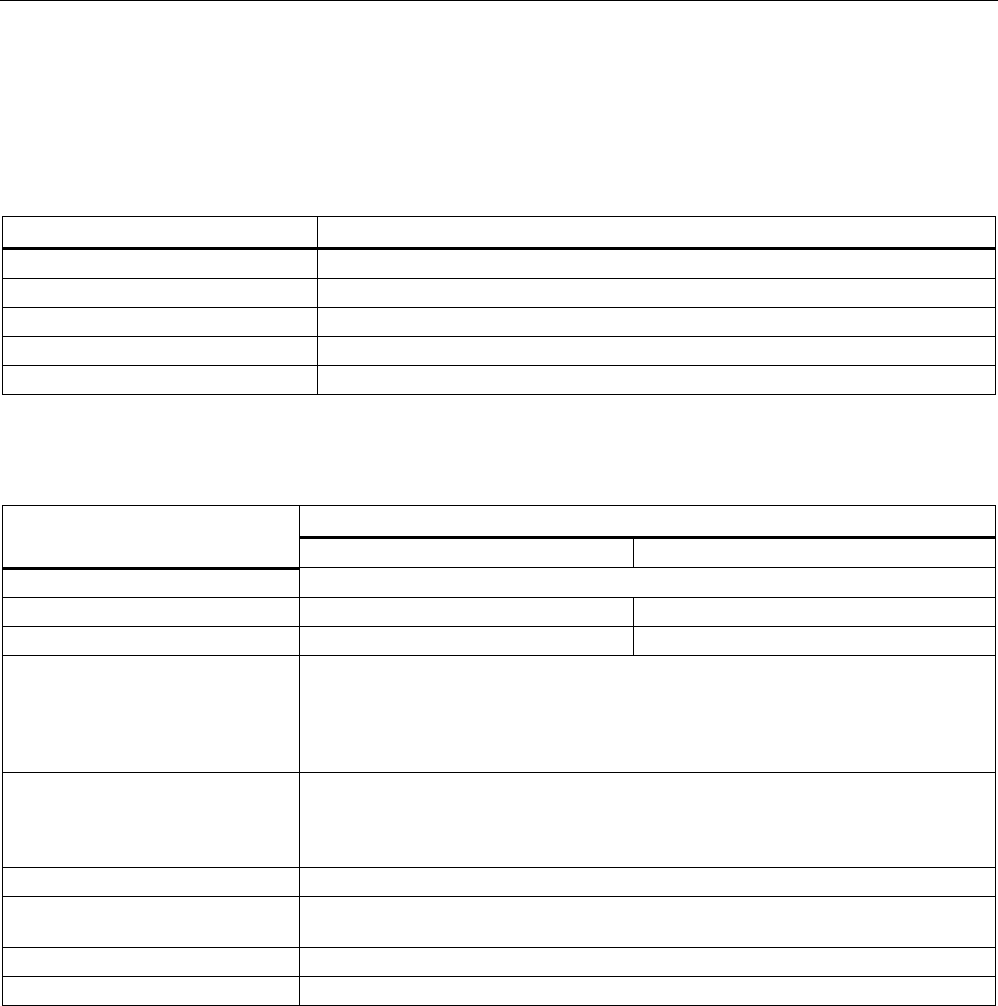
Transponder/tags
7.9 SIMATIC RF680T
SIMATIC RF600
372 System Manual, 05/2012, J31069-D0171-U001-A13-7618
7.9.6 Technical specifications
7.9.6.1 Mechanical data
Property Description
Dimensions (L x W x H) 130 x 32 x 15 mm
Design Plastic housing (PPS)
Housing color Black
Weight Approx. 50 g
Mounting on metal Yes
7.9.6.2 Electrical data
Description Property
Europe USA / Canada
Air interface According to ISO 18 000-6 C
Frequency range 865 … 868 MHz 915 ... 928 MHz
Necessary2) transmit power 2 W (ERP) 4 W (EIRP)
Read distance
• on non-metallic carriers
• On metal1)
• Typ. 4 m
• Typ. 4 m
Write distance
• on non-metallic carriers
• On metal1)
• Typ. 3 m
• Typ. 3 m
Polarization type Linear
Minimum distance to transmitting
antenna
Approx. 0.2 m
Energy source Magnetic energy via antenna, without battery
Multi-tag capability Yes, minimum distance between transponders ≥ 50 mm 3)
1) Plane metal surface 15 x 15 cm, reduction of range to about 70% at the band limit 928 MHz on metal surfaces;
detection is guaranteed at 915 MHz due to frequency hopping procedure.
2) For maximum read/write distances at room temperature
3) When the minimum distances are not reached, there is a reduction in the maximum read and write distances of the
transponders.

Transponder/tags
7.9 SIMATIC RF680T
SIMATIC RF600
System Manual, 05/2012, J31069-D0171-U001-A13-7618 373
7.9.6.3 Memory specifications
Property Description
Type EPC Class 1 Gen2
Memory organization 96 bits/240 bits EPC code
User memory 64 bytes
Protocol ISO 18000-6C
Data retention time 10 years
Read cycles Unlimited
Write cycles Typ. 1 000 000 (at +40 °C)
7.9.6.4 Environmental conditions
Property Description
-25 °C ... +100 °C Permanent
from 100 °C ... +140 °C 20% reduction in the limit
distance
+200 °C 2) Tested up to 5000 hours
or 3000 cycles
• Operation
+220 °C Tested up to 2000 hours
or 1500 cycles
Ambient temperature
• Transport
and storage
-40 °C ... +100 °C
Shock
Vibration
compliant with EN 60721-3-7 Class 7 M3
50 g, 1)
20 g 1)
Torsion and bending load Not permissible
Degree of protection • IP68 according to EN 60529:
(60 minutes. Immersion in cleaning fluids, fluid
depth 5 m top edge of housing)
• Dipping lacquer
• IPx9K
(steam jet: 150 mm; 10 to 15 l/min; 100 bar; 75 °C)
Silicone-free Yes
MTBF 1,6 · 107 h
1) The values for shock and vibration are maximum values and must not be applied continuously.
2) Note that no processing is possible at temperatures of +140 °C or higher.
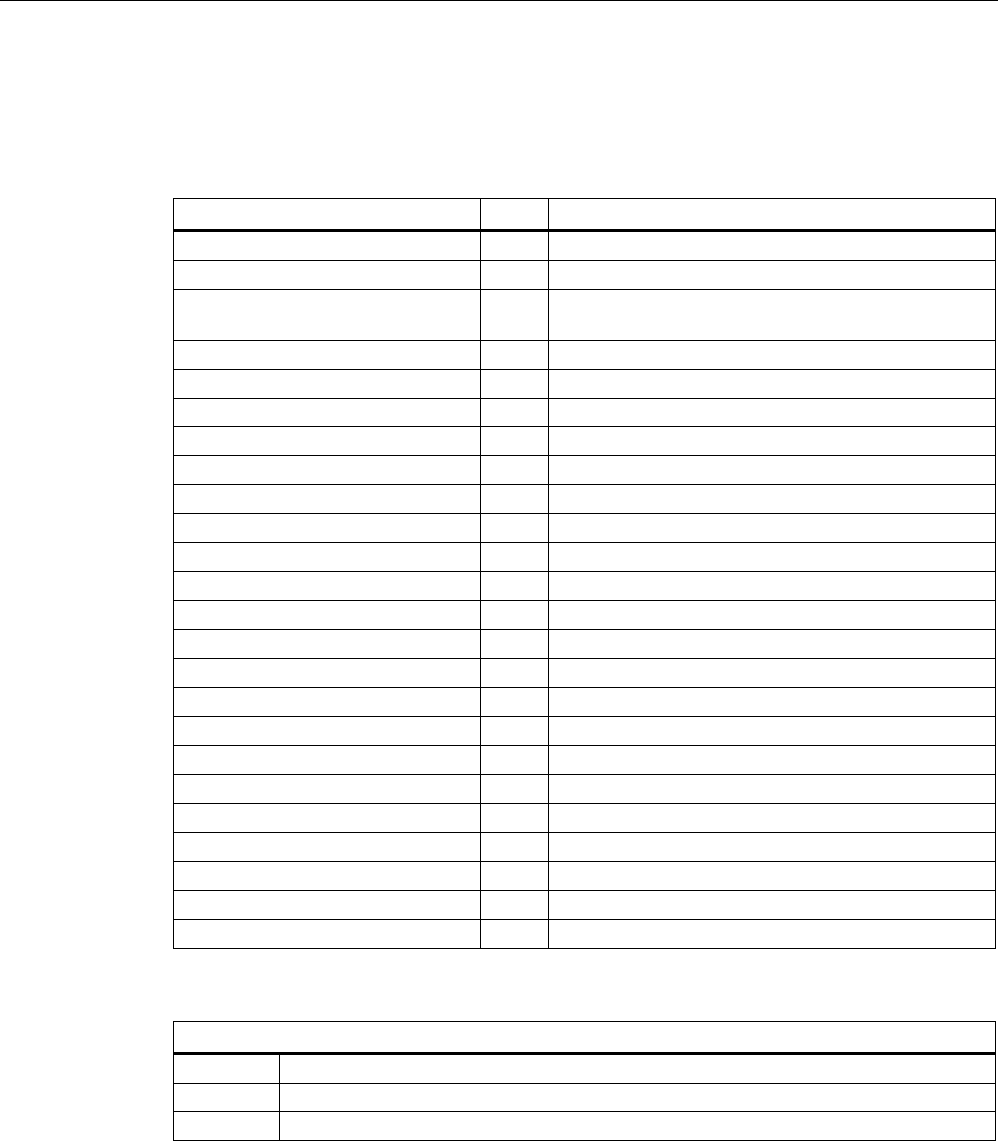
Transponder/tags
7.9 SIMATIC RF680T
SIMATIC RF600
374 System Manual, 05/2012, J31069-D0171-U001-A13-7618
7.9.6.5 Chemical resistance of the RF680T transponder
The following table provides an overview of the chemical resistance of the data memory
made of polypropylene sulfide.
20 °C 65 °C
Ammonia, w. conc. ○ -
Butane gas + +
Butyl acetate (acetic acid butyl
ester)
+ +
Calcium chloride + +
Chlorine - -
Chrome baths, tech. - -
Acetic acid, w. 10% + +
Ethyl alcohol, w., undenaturated + +
Formaldehyde + +
Isopropanol + +
Methyl alcohol + +
Lactic acid, w. + +
Sodium carbonate, w. (soda) + +
Sodium chloride, w. + +
Sodium hydroxide 10% + +
Nitrobenzol ○ -
Phosphoric acid - -
Propane + +
Nitric acid 10% - -
Hydrochloric acid 10% - -
Sulfur dioxide, minimal + +
Sulfuric acid 25% - -
Hydrogen sulfide, dry + +
Carbon tetrachloride ○ -
Abbreviations
+ Resistant
○ Limited resistance
ᅳ Not resistant
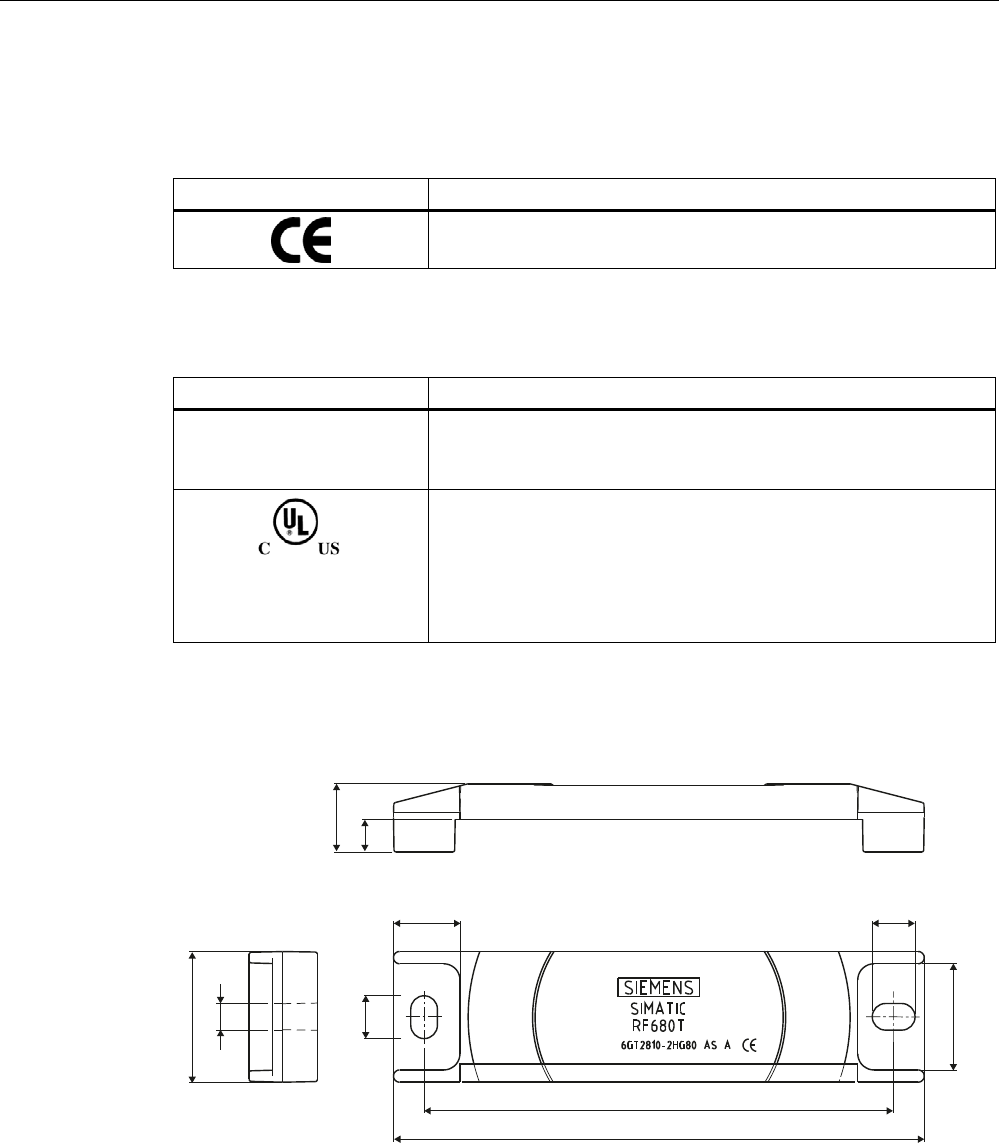
Transponder/tags
7.9 SIMATIC RF680T
SIMATIC RF600
System Manual, 05/2012, J31069-D0171-U001-A13-7618 375
7.9.7 Certificates and approvals
Table 7- 29 6GT2810-2HG80 - RF680T Gen 2 UHF- Europe
Certificate Description
Conformity with R&TTE directive
Table 7- 30 6GT2810-2HG80- RF680T Gen 2 UHF- USA / Canada
Standard
FCC
Federal Communications
Commission
Passive labels or transponders comply with the valid regulations;
certification is not required.
This product is UL-certified for the USA and Canada.
It meets the following safety standard(s):
• UL508 - Industrial Control Equipment
• CSA C22.2 No. 142 - Process Control Equipment
• UL Report E 120869
7.9.8 Dimension drawing
Figure 7-54 Dimension drawing of SIMATIC RF680T
Units of measurement: All dimensions in mm
Tolerances, unless indicated otherwise, are +-0.5 mm.

Transponder/tags
7.9 SIMATIC RF680T
SIMATIC RF600
376 System Manual, 05/2012, J31069-D0171-U001-A13-7618

SIMATIC RF600
System Manual, 05/2012, J31069-D0171-U001-A13-7618 377
Integration into networks 8
8.1 Overview of parameterization of RF600 reader
The parameterization possibilities that are available to you for each reader of the RF600
family are outlined below. You will find detailed information on parameterization in the
specified chapters of the documentation:
Readers SIMATIC command
messages
RF-MANAGER
Basic V2
XML commands RFID reader interface
RF670R Online help > chapter
"Working with RFID
objects"
SIMATIC RF Function
Manual, Chapter
"Standard Configuration
Messages"
RF630R "Configuration Manual
RF620R/RF630R",
chapter "Overview of
commands"
RF620R "Configuration Manual
RF620R/RF630R",
chapter "Overview of
commands"
RF680M Function Manual Mobile
Reader, section "RFID
Reader Interface
Reference"
8.2 Integration in IT networks via the user application
Connecting the readers RF640R/RF670R using XML
If you want to create your own applications for the RF640R/RF670R reader, you can do this
using the XML-based interface of the reader. For detailed information on configuring the
reader using RF-MANAGER Basic V2, refer to the online help. For information about XML
commands, refer to the "SIMATIC RF Function Manual" .
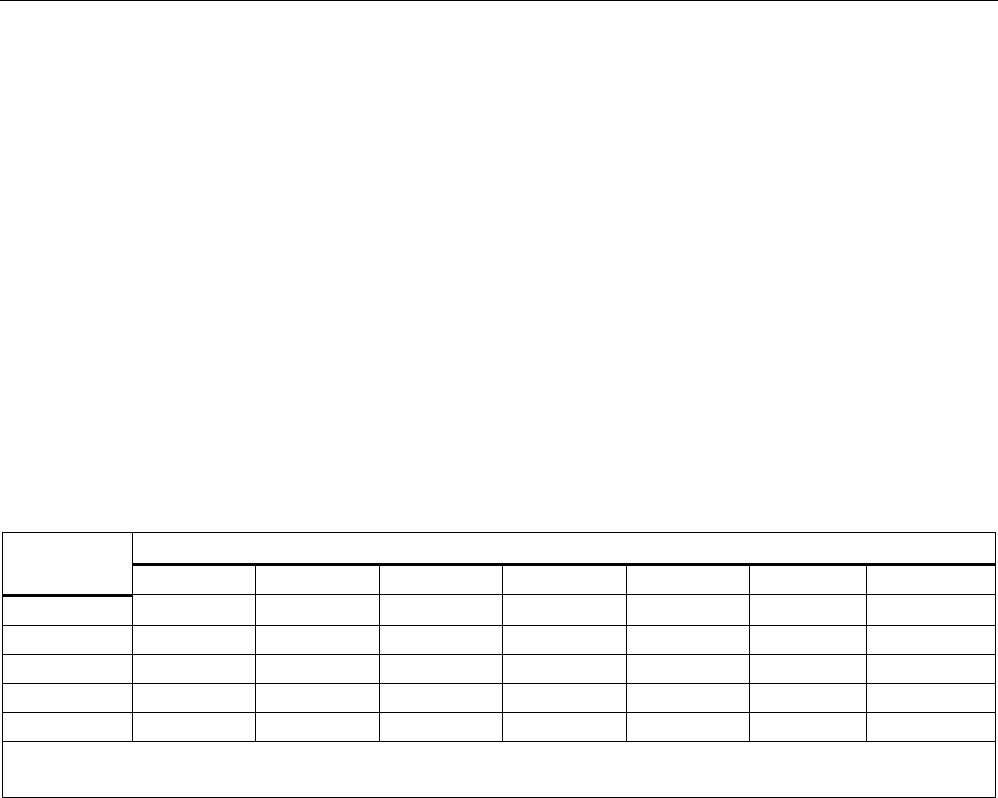
Integration into networks
8.3 Integration in SIMATIC networks
SIMATIC RF600
378 System Manual, 05/2012, J31069-D0171-U001-A13-7618
8.3 Integration in SIMATIC networks
Connecting the readers RF620R/RF630R
RF620R and RF630R readers are connected to the controller via the following
adapter/communication modules:
● SIMATIC RF170C
● SIMATIC RF180C
● ASM 456
The RF182C communication module is connected with the PC directly over Ethernet.
Function blocks, interface modules/communication modules and readers
Table 8- 1 Table of reader/interface modules
Interface modules/communication modules
Function
blocks ASM 456 RF170C 1) RF180C ASM 475 RF182C RF160C RFID 181EIP
FB 45 1 - 2 readers 1 - 2 readers 1 - 2 readers 1 - 2 readers N/A N/A N/A
FB 55 1 - 2 readers 1 - 2 readers 1 - 2 readers 1 - 2 readers N/A N/A N/A
XML N/A N/A N/A N/A 1 - 2 readers N/A N/A
FC 44 N/A N/A N/A N/A N/A 1 - 2 readers N/A
Ethernet/IP N/A N/A N/A N/A N/A N/A 1 - 2 readers
With all possible combinations, the input voltage at the communications module must not be below 21.6 V.
1) If 2 readers are used with an RF170C, the CM/ASM can only be operated with a ambient temperature of max. 55 °C.
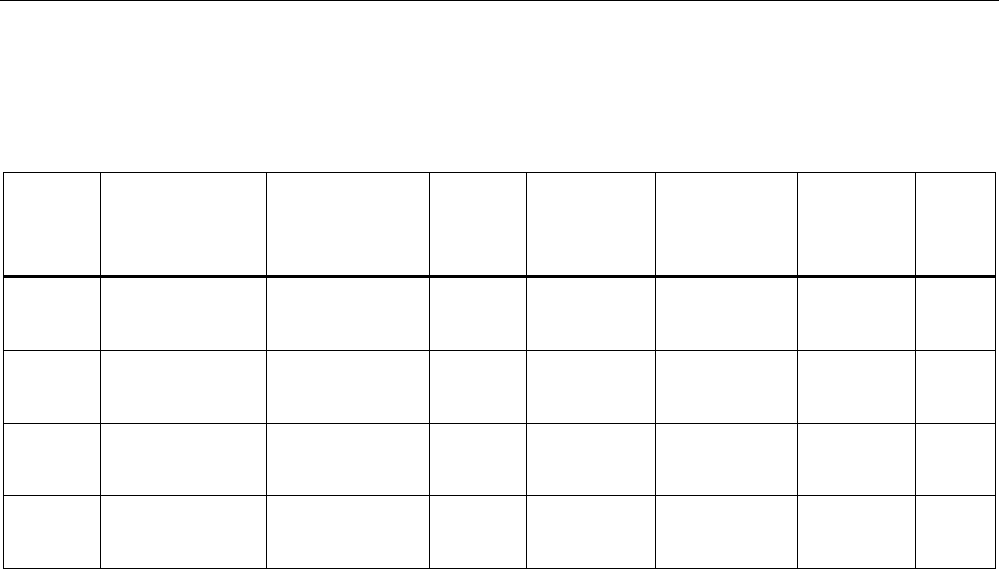
Integration into networks
8.3 Integration in SIMATIC networks
SIMATIC RF600
System Manual, 05/2012, J31069-D0171-U001-A13-7618 379
Interface modules/communication modules and function blocks
Table 8- 2 Overview of interface modules/communication modules
ASM/CM Interfaces to the
application (PLC)
Interfaces to the
reader
Function
blocks
Reader
connections
Dimensions
(W x H x D) in
mm
Temperature
range
Degree
of
protecti
on
ASM 456 PROFIBUS DP-V1 2 x 8-pin
connection socket,
M12
FB 45
FC 55
2 (parallel) 60 x 210 x 54
or 79
0 ... +55 °C IP67
SIMATIC
RF170C
PROFIBUS DP-V1
PROFINET IO
2 x 8-pin
connection socket,
M12
FB 45
FC 55
2 (parallel) 90 x 130 x 60 -25 ... 55° C IP67
SIMATIC
RF180C
PROFINET IO 2 x 8-pin
connection socket,
M12
FB 45 2 (parallel) 60 x 210 54
0 ... +60° C IP67
SIMATIC
RF182C
TCP/IP 2 x 8-pin
connection socket,
M12
- 2 (parallel) 60 x 210 x 54 0 ... +60° C IP67
The following table shows which readers can be connected to which interface
modules/communication modules.
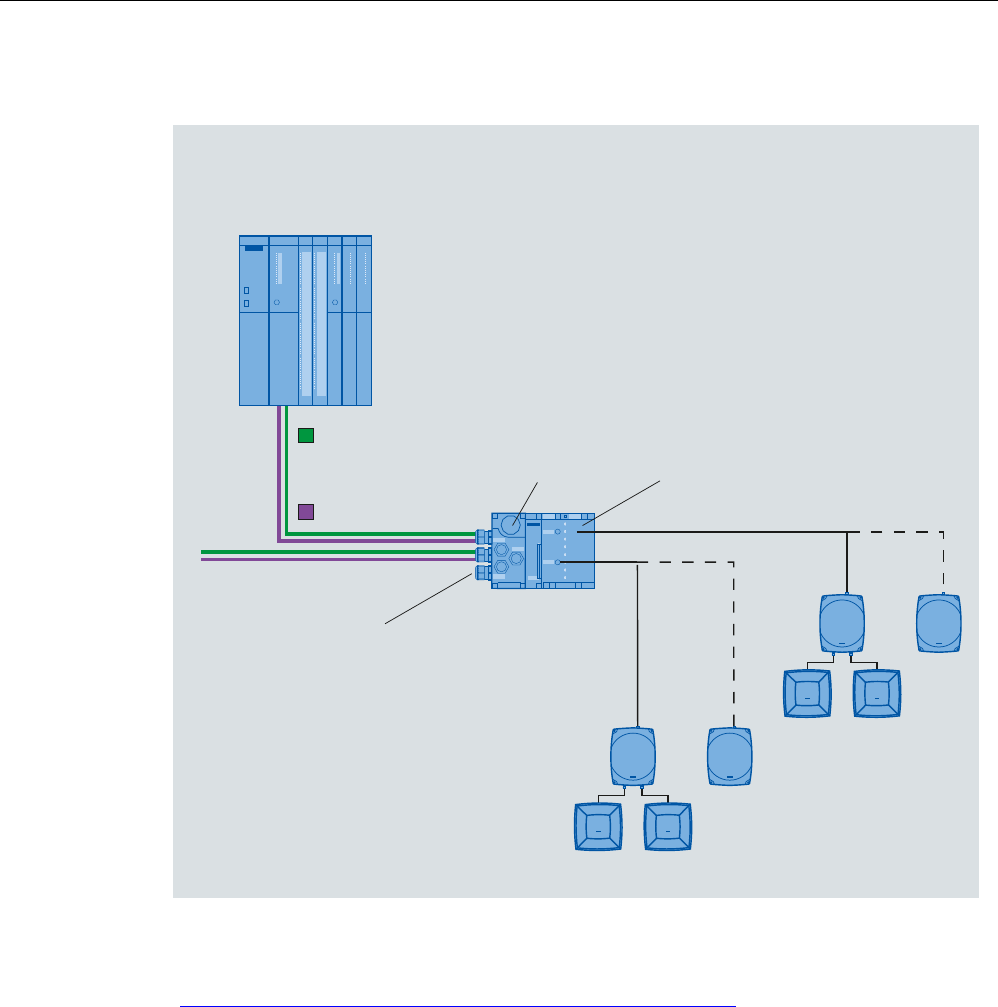
Integration into networks
8.3 Integration in SIMATIC networks
SIMATIC RF600
380 System Manual, 05/2012, J31069-D0171-U001-A13-7618
Configuration with SIMATIC RF170C
or
or
PROFIBUS or
PROFINET/Industrial Ethernet
Master module
SIMATIC S7
24 V for
ET 200pro, RF170C
and reader
PROFINET/
Industrial Ethernet
or
Interface module
ET 200pro
PROFIBUS
SIMATIC
RF170C
RF630R RF620R
RF630R RF620R
Figure 8-1 Configuration with SIMATIC RF170C
For more detailed information, please refer to SIMATIC RF170C Operating Instructions
(http://support.automation.siemens.com/WW/view/en/32622825).
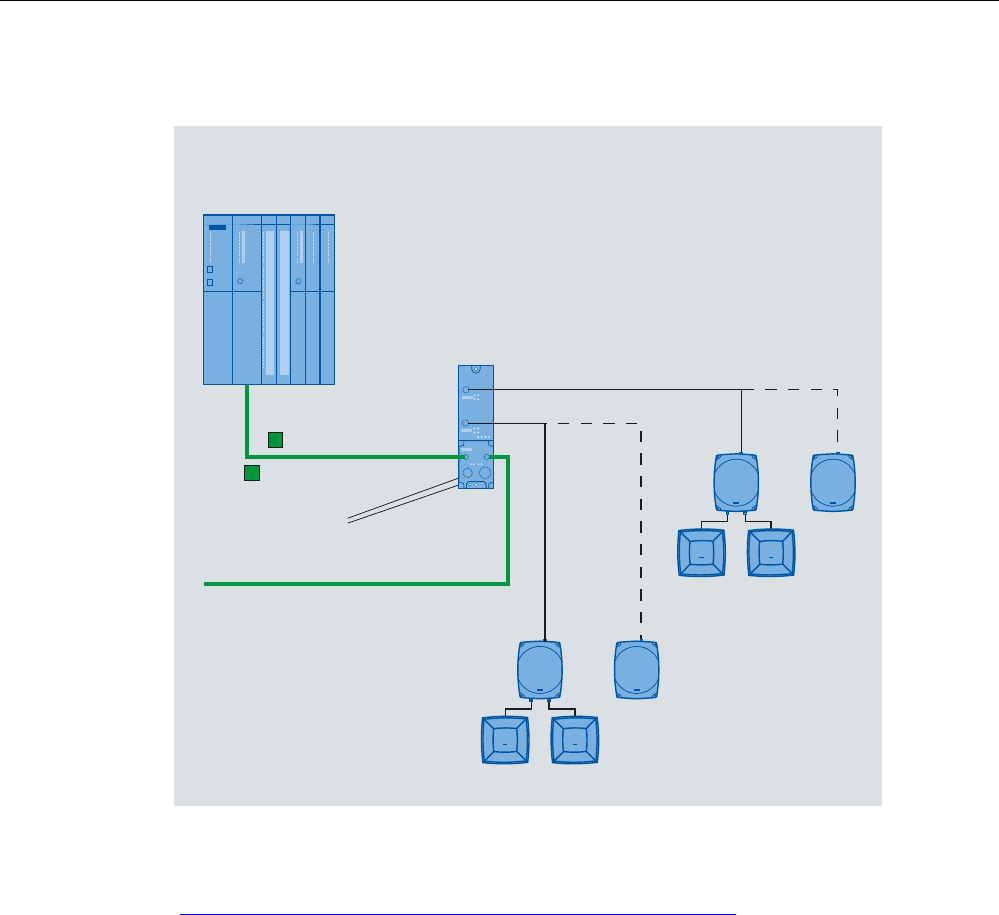
Integration into networks
8.3 Integration in SIMATIC networks
SIMATIC RF600
System Manual, 05/2012, J31069-D0171-U001-A13-7618 381
Configuration with SIMATIC RF180C
PROFINET IO
Master module
SIMATIC S7
24 V for
RF180C and reader
To rest of PROFINET
bus nodes
or
or
Industrial Ethernet
PROFINET
SIMATIC
RF180C
RF630R RF620R
RF630R RF620R
Figure 8-2 Configuration with SIMATIC RF180C
For more detailed information, please refer to SIMATIC RF180C Operating Instructions
(http://support.automation.siemens.com/WW/view/en/30012157).
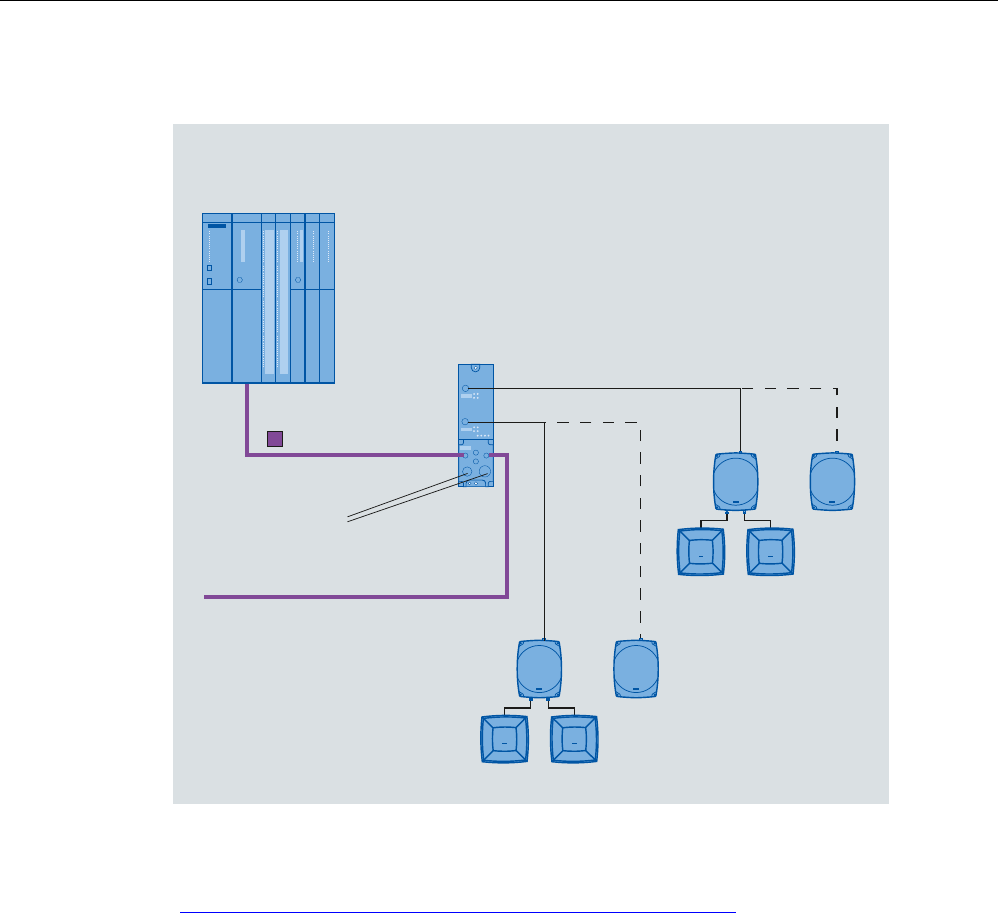
Integration into networks
8.3 Integration in SIMATIC networks
SIMATIC RF600
382 System Manual, 05/2012, J31069-D0171-U001-A13-7618
Configured with ASM 456
X2
PROFIBUS DP
Master module
SIMATIC S7
24 V for
ASM 456 and reader
to other PROFIBUS
bus nodes
or
or
PROFIBUS
ASM 456
X1
RF630R RF620R
RF630R RF620R
X2
Figure 8-3 Configured with ASM 456
For more detailed information, please refer to ASM 456 Operating Instructions
(http://support.automation.siemens.com/WW/view/en/32629442).
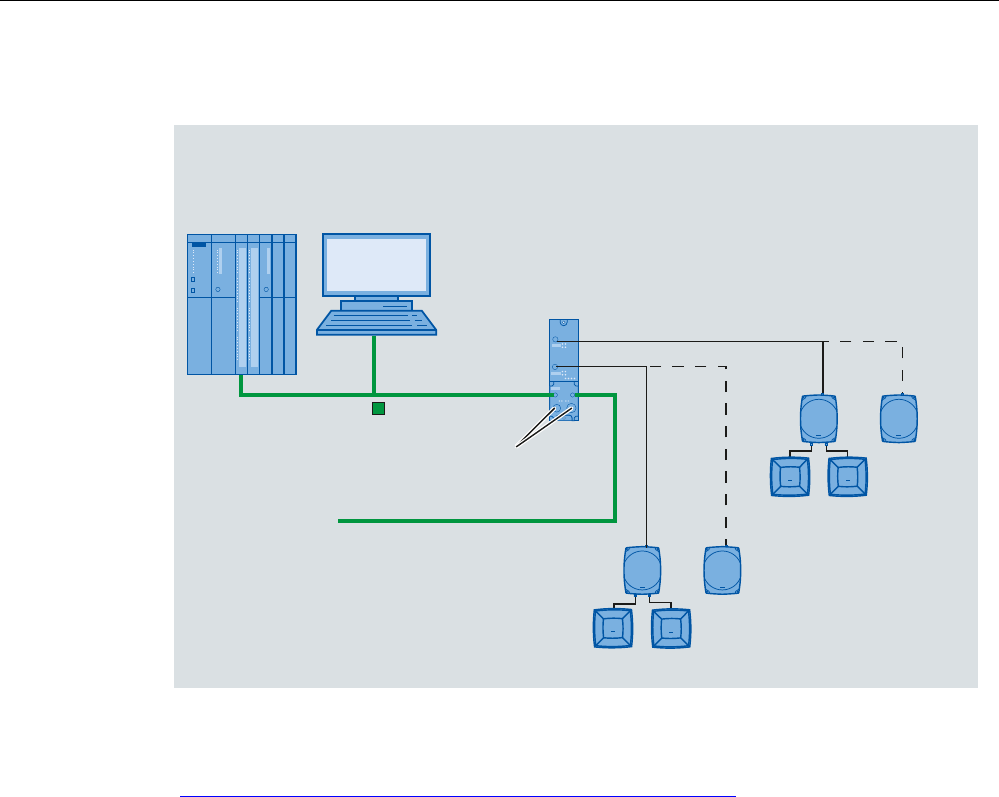
Integration into networks
8.3 Integration in SIMATIC networks
SIMATIC RF600
System Manual, 05/2012, J31069-D0171-U001-A13-7618 383
Configuration with RF182C
,QGXVWULDO(WKHUQHW
or
or
352),1(7b,2
9IRU
5)&DQGUHDGHU
7RDGGLWLRQDO352),1(7(WKHUQHWQRGHV
6,0$7,&
5)&
3&
PROFINET IO
Master module
SIMATIC S7
RF630R RF620R
RF630R RF620R
Figure 8-4 Configuration with SIMATIC RF182C
For more information, see SIMATIC RF182C Operating Instructions
(http://support.automation.siemens.com/WW/view/en/38507897)

Integration into networks
8.3 Integration in SIMATIC networks
SIMATIC RF600
384 System Manual, 05/2012, J31069-D0171-U001-A13-7618
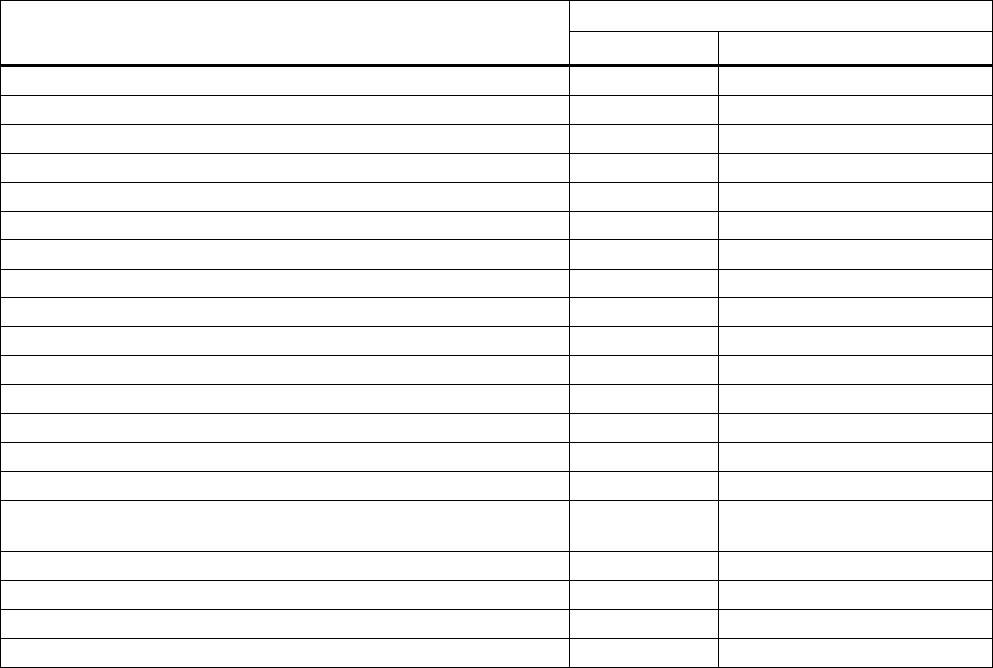
SIMATIC RF600
System Manual, 05/2012, J31069-D0171-U001-A13-7618 385
System diagnostics 9
9.1 Flashing codes of the RF600 readers with Ethernet interface
Flashing of ERR LED Error description
Number Repetitions
Reader inactive, no configuration data Lit constantly Permanent
Antenna 1 not connected or defective 3 Permanent
Antenna 2 not connected or defective 4 Permanent
Antenna 3 not connected or defective 5 Permanent
Antenna 4 not connected or defective 6 Permanent
Reading of user-defined memory has failed 11 3 times
Writing of user-defined memory has failed 12 3 times
The "SendCommand" function has failed 13 3 times
Wrong or missing password 14 3 times
Writing of the tag ID has failed 15 3 times
LOCK has failed 16 3 times
KILL has failed 17 3 times
Access to impermissible memory areas 18 3 times
Too many tags in the field 19 3 times
General software errors 20 Permanent
Impermissible message frame;
Impermissible message frame parameter
29 3 times
Incorrect message frame format 30 3 times
The "SetReadProtect" NXP function has failed 31 3 times
The "ResetReadProtect" NXP function has failed 32 3 times
General error during detection of tags (inventory) 33 3 times
The LED states are described in chapter Status display (Page 165).
9.2 Error messages RF600 reader
A description of the RF640R/RF670R error codes can be found in the "SIMATIC RF Function
Manual".

System diagnostics
9.3 Error messages and flash codes for RF620R/RF630R
SIMATIC RF600
386 System Manual, 05/2012, J31069-D0171-U001-A13-7618
9.3 Error messages and flash codes for RF620R/RF630R
error_MOBY
The ERR LED of the reader flashes when the ASM reports error messages.
Table 9- 1 Error messages of the MOBY-ASM via the "error_MOBY" variable
Error code
(B#16#..)
Flashing of
ERR LED
Description
00 – No error
Default value if everything is ok.
1x Boot message
01 2x Presence error, possible causes:
• The active command was not carried out completely
• The tag has left the field while the command is being processed
• Communication fault between reader and tag
The next command is automatically executed on the next tag. A read
or write command is possible.
02 2x Presence error: A tag has passed by a reader without being processed
by a MOBY command.
• This error message is not reported immediately. Instead, the ASM
waits for the next command (read, write). This command is
immediately replied to with this error. This means that a read or
write command is not processed. The next command is executed
normally by the ASM again. An init_run from FB 45 also resets this
error state.
• Bit 2 is set in parameter "option_1" and no tag is in the transmission
window.
03 3x Error in the connection to the reader. The reader does not answer.
• Cable between MOBY ASM and reader is wired incorrectly or cable
break.
• Antenna error: (Cable is defective), cable is no longer connected
• The 24 V supply voltage is not connected or is not on or has failed
briefly.
• Automatic fuse on the ASM has blown.
• Hardware defect
• Another reader is in the vicinity and is active.
• Interference on reader - or PROFIBUS line
• Execute init_run after error correction

System diagnostics
9.3 Error messages and flash codes for RF620R/RF630R
SIMATIC RF600
System Manual, 05/2012, J31069-D0171-U001-A13-7618 387
Error code
(B#16#..)
Flashing of
ERR LED
Description
04 4x Error in tag memory
The tag has never been write-accessed or has lost the contents of its
memory due to battery failure.
• Replace tag (if battery bit is set).
• Initialize tag with the STG
• Re-initialize tag
05 5x • Unknown command
• Incorrect parameter
• Function not allowed
• Mode in SET-ANT command unknown
FB 45/FC 55 is sending an uninterpretable command to the MOBY-
ASM.
• Command_DB contains invalid command parameters.
• The command_DB was overwritten by the user
• The MDS reported an address error.
06 6x Field disturbance on reader
The reader is receiving interference pulses from the environment.
• The distance between two readers is too small and does not
correspond to the configuration guidelines
• The connecting cable to the reader is defective or too long or does
not comply with the specification
07 7x No free ETSI transmit channel
09 Wrong communications standard selected in the init_run command
(e.g. FCC in ETSI reader)
0B 11x Tag memory cannot be read correctly or cannot be written.
Tag reports an error:
• Other error (00000000B) *
• Insufficient power (00001011B): Tag is in the limit range *
• Non-specific error (00001111B) *
0C 12x The tag memory cannot be write-accessed.
• Tag memory is defective
• Memory is write-protected (Memory Locked: 000000100B)
(The tag memory is PERMA-locked and cannot be overwritten or
the reader password has to be reset)
0D 13x Error in specified address (address error)
• The specified address does not exist on the tag
• The command must be checked and corrected.
• This is not the correct tag type.
• Access attempted to non-existent or non-accessible memory areas
( Memoryoverrun: 00000011B)

System diagnostics
9.3 Error messages and flash codes for RF620R/RF630R
SIMATIC RF600
388 System Manual, 05/2012, J31069-D0171-U001-A13-7618
Error code
(B#16#..)
Flashing of
ERR LED
Description
0E 14x Password error
• Incorrect tag password (the reader password must be set again so
that is agrees with the password).
0F 1x Start-up message from ASM. The ASM was off and has not yet
received an init_run command
• Execute an init_run
• The same physical ASM channel is used in two (or more) UDT 10
structures. Check the ASM_address and ASM_channel in
all
UDT
10 structures.
10 16x NEXT command not possible or not permitted
• ASM is operating without MDS control (MDS_control = 0.1)
• ASM has already received a Next command.
• ASM / write/read device doesn't recognize NEXT command.
REPEAT after forbidden commands:
• REPEAT for SET-ANT
• REPEAT for SLG status
11 – Short circuit or overload of the 24 V outputs (DQ, error code, presence)
• The affected output is turned off.
• All outputs are turned off when total overload occurs.
• A reset can only be performed by turning the 24 V voltage off and
on again.
• Then start init_run.
12 18x Internal ASM communication error
• Connector contact problem on the ASM
• Defective ASM hardware
– Return ASM for repair
• Start init_run command after error correction.
13 19x • ASM/reader does not have enough buffer to store the command
intermediately.
• Maximum allowable number of 150 commands in a command chain
was ignored. If REPEAT is used in connection with a command
chain, the maximum number of commands is also 150 (including
the REPEAT command).
If a command chain contains more than 150 commands, after the
150th command is called, it will be canceled and the above error
message will be sent without processing the complete chain.
Commands in the command chain that have already been
executed can still be sent later after the error message "0x13" is
sent.

System diagnostics
9.3 Error messages and flash codes for RF620R/RF630R
SIMATIC RF600
System Manual, 05/2012, J31069-D0171-U001-A13-7618 389
Error code
(B#16#..)
Flashing of
ERR LED
Description
14 20x Internal ASM / write/read device error
• Program sequence error on the ASM
• Turn power of ASM off and on again.
• Start init_run command after error correction.
• Watchdog error on reader
15 21x Wrong parameterization of the ASM/reader
• Check INPUT parameters in UDT 10
• Check parameters in HW Config
• Transmit power set too high
• Unused parameter bits are not 0.
• init_run command is parameterized incorrectly
• After a start-up, the ASM has still not received an init_run.
• Parameter scanning_time = 0x00 was set (no standard selected).
16 22x The FB command cannot be executed with the ASM parameters on
PROFIBUS.
• Length of the input/output areas too small for the cyclic I/O word.
Did you use the right GSD file?
• FB command (e.g. read) has too much user data (data length >
233 bytes)
17 23x Communication error between FB 45/FC 55 and MOBY-ASM.
Handshake error
• Params_DB (UDT 10) of this ASM station is being overwritten by
other parts of the program
• Check parameters of MOBY-ASM in UDT 10
• Check FB 45/FC 55 command which caused this error.
• Start init_run command after error correction.
18 – An error has occurred which must be acknowledged with an init_run.
• A temporary short circuit has occurred on PROFIBUS.
• The init_run command is faulty
• Start init_run command after error correction.
• Check parameters ASM_address, ASM_channel, and
MOBY_mode.

System diagnostics
9.3 Error messages and flash codes for RF620R/RF630R
SIMATIC RF600
390 System Manual, 05/2012, J31069-D0171-U001-A13-7618
Error code
(B#16#..)
Flashing of
ERR LED
Description
19 25x Previous command is active or buffer overflow.
The user sent a new command to the ASM although the last command
was still active.
• Active command can only be terminated with an init_run.
• Before a new command can be started the READY bit must be 1
(exception: init_run).
• Two FB 45/FC 55 calls were parameterized with the same
parameters "ASM_address" and "ASM_channel"
• Two FB 45/FC 55 calls are using the same Params_DB pointer
• Start init_run command after error correction.
• When command repetition (e.g. read-only MDS) is used, no data
are fetched from the tag. The data buffer on the ASM has
overflowed. Tag data have been lost.
1A – PROFIBUS DP error occurred.
• The PROFIBUS DP bus connection was interrupted
– Wire break on the bus
– Bus connector on ASM was removed briefly
• PROFIBUS DP master no longer addresses the ASM
• Execute an init_run
• The ASM has detected a message frame interruption on the bus.
The PROFIBUS may have been reconfigured (e.g. with HW
Config).
This error is only indicated when access monitoring has been enabled
in the PROFIBUS configuration.
1B 27x There is an inconsistency in the parameterization of the reader. In
expert mode, parameters were probably set which the reader cannot
use.
• ETSI performance testing faulty
1C 28x • Antenna is already switched off
• Antenna is already switched on
• Mode in SET-ANT command not recognized.

System diagnostics
9.3 Error messages and flash codes for RF620R/RF630R
SIMATIC RF600
System Manual, 05/2012, J31069-D0171-U001-A13-7618 391
Error code
(B#16#..)
Flashing of
ERR LED
Description
1D – More MDSes are in the transmission window than the SLG is capable
of processing simultaneously.
• Only 1 MDS can be processed at a time with FB 45.
• With FB 45 and FC 55: there is more than one tag with the same
EPC ID in the antenna field of the reader.
• With FC 55: Increase the value in multitag or decrease the number
of MDSes in the field.
• With FC 55: A read or write command has been sent on a
transponder (UID) and there are one or more transponders in the
antenna field, for which the contents of the addresses FF00 – FF03
of the EPC ID do not agree (unambiguity when transponder is
accessed via 8-byte long UID).
• Power supply of the MDS in the limit range:
Due to short-term power shortage, an MDS loses its
communications status (session), upon which the identical EPC-ID
is sent a second time as soon as the power threshold is exceeded
again.
Increase the reader's radiated power and/or reduce the distance
between antenna and MDS until this effect no longer occurs.
1E 30x Wrong number of characters in the command message frame.
1F 31 Running command canceled by RESET (init_run or cancel) or bus
connector removed
• Communication with the tag was terminated by init_run.
• This error can only be reported on init_run or cancel
*) You will find the meaning of the error numbers in the EPC Global Class 1 Gen 2 document, Annex
I.

System diagnostics
9.3 Error messages and flash codes for RF620R/RF630R
SIMATIC RF600
392 System Manual, 05/2012, J31069-D0171-U001-A13-7618
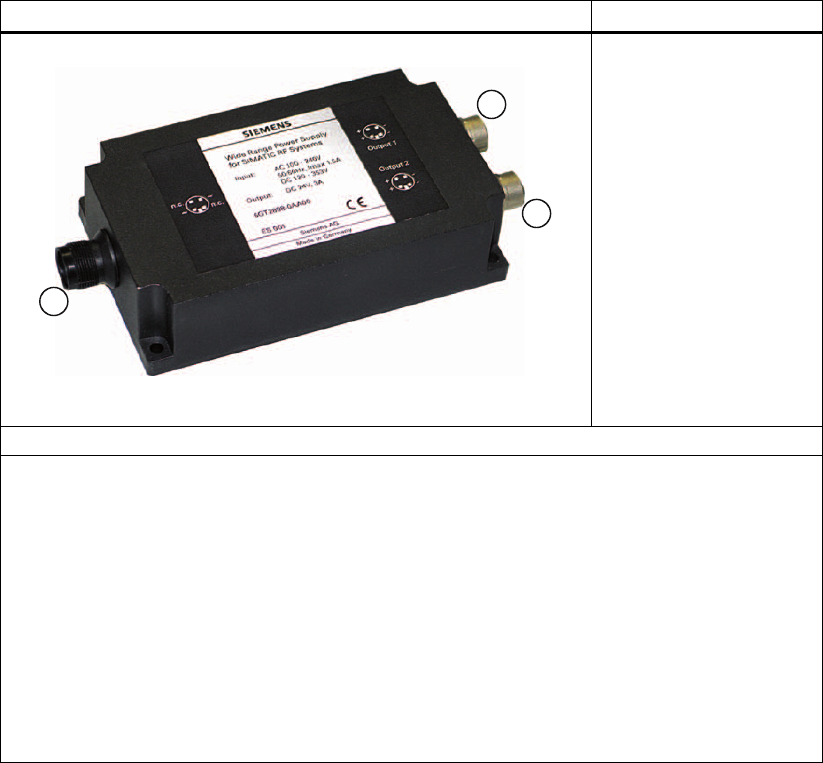
SIMATIC RF600
System Manual, 05/2012, J31069-D0171-U001-A13-7618 393
Accessories 10
10.1 Wide-range power supply unit for SIMATIC RF systems
10.1.1 Features
Wide-range power supply unit for SIMATIC RF systems
(1) DC output 1
(2) DC output 2
(3) Mains connection
Features
• Wide-range input (3) for use worldwide
• Dimensions without mains cable: 175 x 85 x 35 mm
• Dimensions including mains cable: 250 x 85 x 35 mm
• CE-compliant (EU and UK versions)
• UL-certified for US and Canada (US version)
• Mechanically and electrically rugged design
• Secondary side (1), (2): 24 V DC / 3 A
• Short-circuit and no-load stability
• Suitable for frame mounting
• 3 versions for use in the EU, UK, US

Accessories
10.1 Wide-range power supply unit for SIMATIC RF systems
SIMATIC RF600
394 System Manual, 05/2012, J31069-D0171-U001-A13-7618
Description
The wide-range power supply unit for SIMATIC RF systems is a universal compact power
supply and provides the user with an efficient, cost-saving solution for many different mid-
range power supply tasks.
The primary switched power supply is designed for use on single-phase AC systems. The
two DC outputs (sockets) are connected in parallel and protected by a built-in current limiting
circuit against overload and short-circuits.
The device is vacuum-cast and prepared for Safety Class 2 applications. The EU and UK
versions satisfy the low-voltage guideline as well as the current EU standards for CE
conformity. Furthermore, the US version has been UL-certified for the US and Canada.
10.1.2 Scope of supply
● Wide-range power supply unit for SIMATIC RF systems
● 2 m mains cable (country-specific)
● Protective cover for flange outlet
● Operating Instructions
10.1.3 Ordering data
Wide-range power supply unit for SIMATIC RF-systems
(100 - 240 VAC / 24 VDC / 3 A)
with 2 m connecting cable with country-specific plug
EU: 6GT2898-0AA00
UK: 6GT2898-0AA10
US: 6GT2898-0AA20
24 V connecting cable for SIMATIC RF640R/RF670R,
length 5 m
6GT2891-0NH50
Note
Risk of confusion
Note that you cannot use the 24 V connecting cables of the discontinued RF660R reader for
the RF640R and RF670R readers.
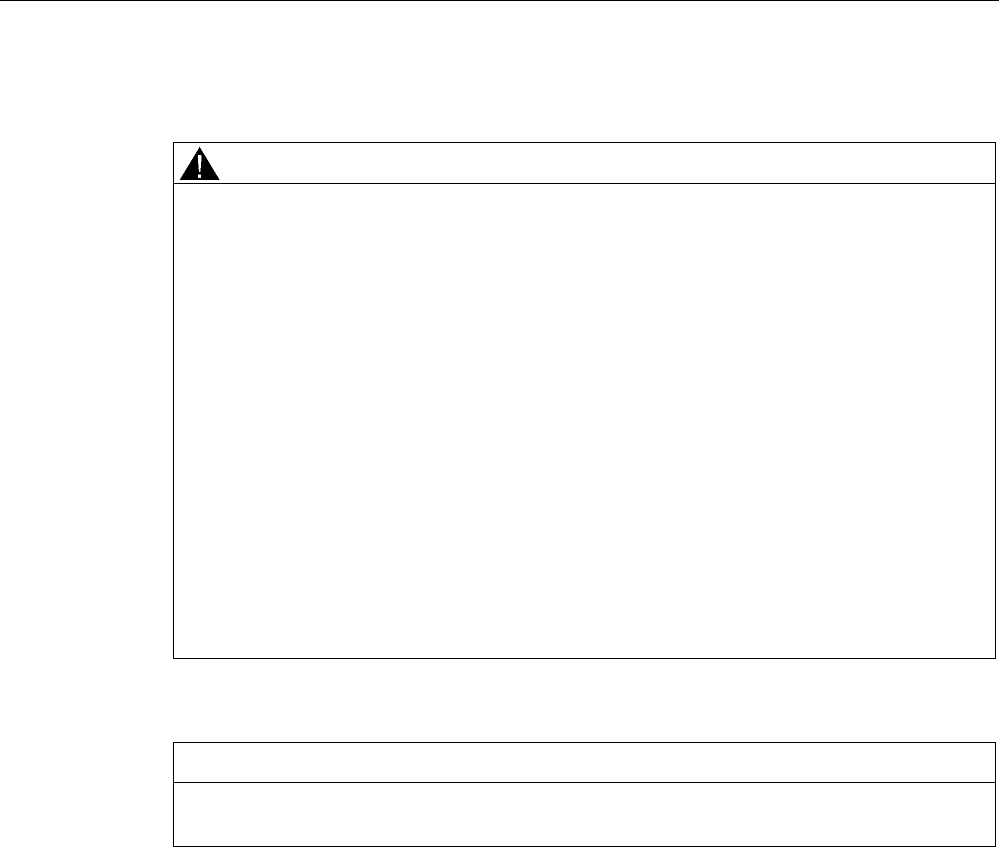
Accessories
10.1 Wide-range power supply unit for SIMATIC RF systems
SIMATIC RF600
System Manual, 05/2012, J31069-D0171-U001-A13-7618 395
10.1.4 Safety Information
WARNING
Danger to life
It is not permitted to open the device or to modify the device.
The following must also be taken into account:
• Failure to observe this requirement shall constitute a revocation of the CE approval, UL
certification for the US and Canada as well as the manufacturer's warranty.
• For installation of the power supply, compliance with the DIN/VDE requirements or the
country-specific regulations is essential.
• The field of application of the power supply is limited to "Information technology in
electrical office equipment" within the scope of validity of the EN 60950/VDE 0805
standard.
• When the equipment is installed, it must be ensured that the mains socket outlet is
freely accessible.
• The housing can reach a temperature of +25 °C during operation without any adverse
consequences. It must, however, be ensured that the power supply is covered in the
case of a housing temperature of more than +25°C to protect persons from contact with
the hot housing. Adequate ventilation of the power supply must be maintained under
these conditions.
NOTICE
The wide-range power supply unit must only be used for SIMATIC products in the
specifically described operating range and for the documented intended use.
If the wide input range power supply for SIMATIC RF systems is used for an end product
other than the SIMATIC RF600 system, the following must be taken into account:
● The electric strength test of the end product is to be based upon a maximum working
voltage of: Transition from primary to SELV: 353 VDC, 620 Vpk
● The following secondary output circuits are SELV (low voltage; SELV = Safety Extra Low
Voltage): all
● The following secondary output circuits are at non-hazardous energy levels: all
● The power supply terminals and/or connectors are suitable for field wiring if terminals are
provided.
● The maximum investigated branch circuit rating is: 20 A
● The investigated pollution degree is: 2
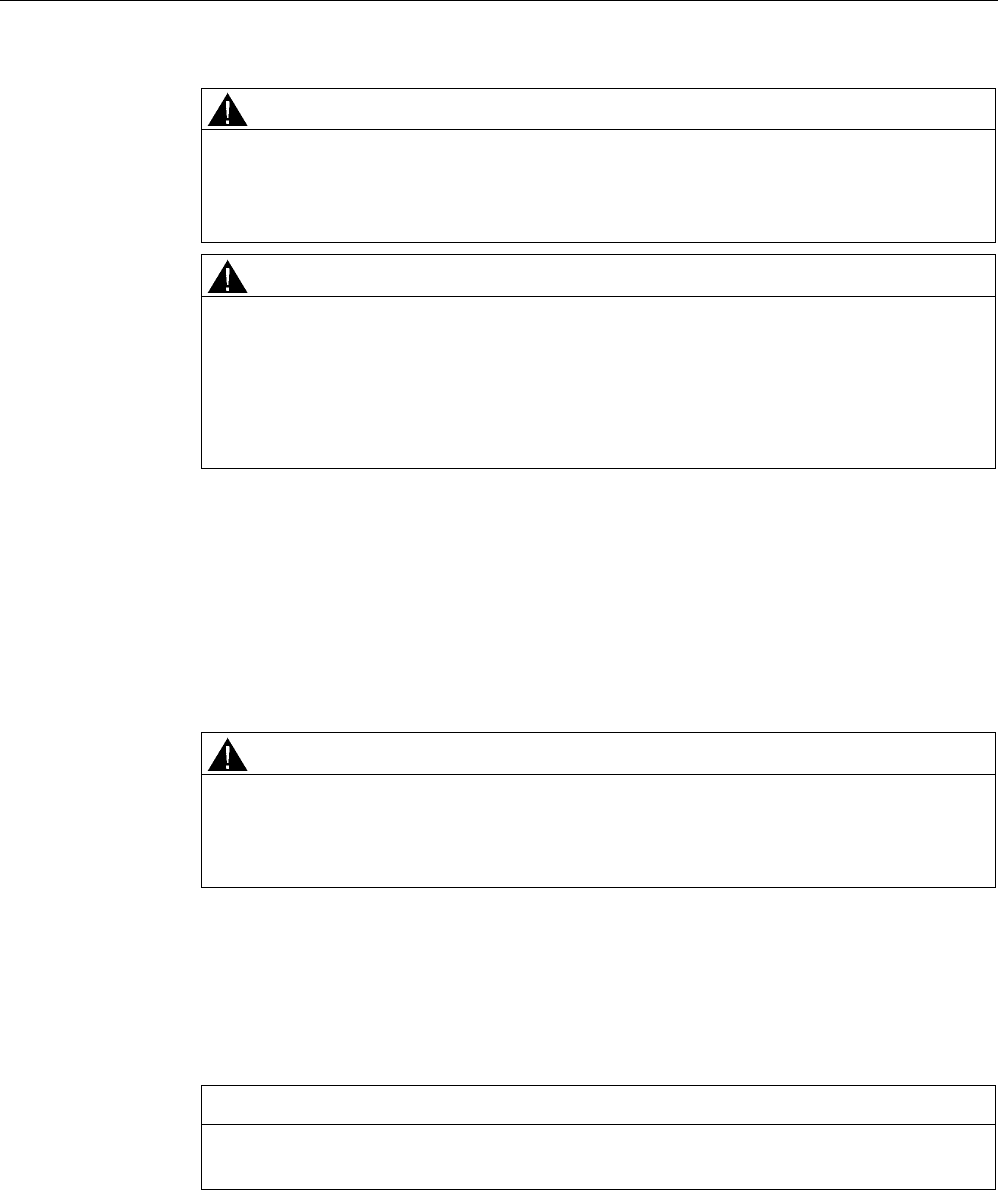
Accessories
10.1 Wide-range power supply unit for SIMATIC RF systems
SIMATIC RF600
396 System Manual, 05/2012, J31069-D0171-U001-A13-7618
WARNING
If the wide input range power supply for SIMATIC RF systems is connected to an end
product other than end products of the RF600 family, the end user is responsible and
liable for operation of the system or end product that includes the wide input range
power supply for SIMATIC RF systems.
WARNING
Alterations to the SIMATIC RF600 components and devices as well as the use of
SIMATIC RF600 components with third-party RFID devices are not permitted.
Failure to observe this requirement shall constitute a revocation of the radio equipment
approvals, CE approval and manufacturer's warranty. Furthermore, the compliance to
any salient safety specifications of VDE/DIN, IEC, EN, UL and CSA will not be
guaranteed.
Safety notes for the US and Canada
The SIMATIC RF640R/RF670R reader may only be operated with the wide range power
supply unit for SIMATIC RF systems - as an optional component – or with power supply units
that are UL-listed according to the safety standards specified below:
● UL 60950-1 - Information Technology Equipment Safety - Part 1: General Requirements
● CSA C22.2 No. 60950 -1 - Safety of Information Technology Equipment.
WARNING
The compliance of the SIMATIC RF600 system to the safety standards mentioned
above will not be guaranteed if neither the wide-range power supply unit for SIMATIC
RF systems°nor power supplies listed according to the safety standards above are
used.
10.1.5 Connecting
● There are three different (country-specific) mains cables for the EU, UK and US.
The appropriate mains cable must be connected to the primary input of the power supply.
NOTICE
It is only permissible to insert or remove the mains cable when the power supply is de-
energized.
● The wide-range power supply unit has total insulation (Safety Class 2), IP65
● It can be mounted using four fixing holes.
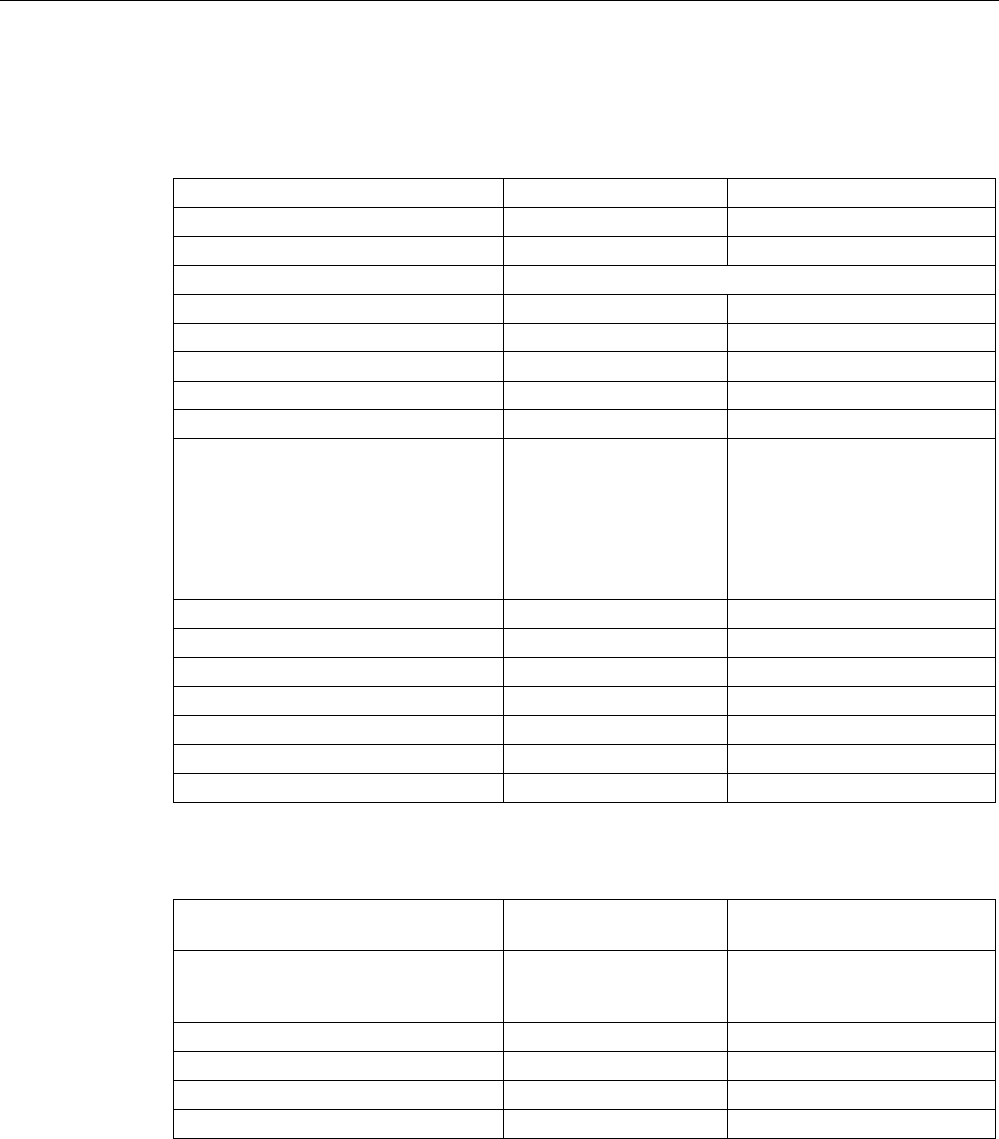
Accessories
10.1 Wide-range power supply unit for SIMATIC RF systems
SIMATIC RF600
System Manual, 05/2012, J31069-D0171-U001-A13-7618 397
10.1.6 Technical specifications
Table 10- 1 General technical specifications
Insulation stability (prim./sec.) Uins p/s 3.3 kVAC
Insulation resistance Rins >1 GΩ
Leakage current Ileak U
in = 230 VAC, f = 50 Hz < 200 µA
Safety class (SELV) Designed for installation in devices of Safety Class 2
Mains buffering th U
in = 230 VAC ≥ 50 ms
Ambient temperature -25 °C to +55 °C
Surface temperature Module top, center Max. 96 °C
Storage temperature -40 °C to +85 °C
Self-heating on full-load max. 45 K
Interference immunity
ESD
HF fields
Burst
Surge
HF injection
Mains quality test
EN 61000-4-2,
4-3 up to 4-6, 4-11
Air discharge: 15 kV
10 V/m
symmetrical: 2
Symmetrical: 1
10 Vrms
Cooler Free convection
Dimensions L x W x H 175 mm x 85 mm x 35 mm
Weight 720 g
Housing / casting UL 94-V0
Power supply class according to CSA Level 3
Degree of protection IP65
MTBF in years 255
Table 10- 2 Technical specifications for the input
Rated input voltage Uin EN 60950 / UL 60950 100 to 240 VAC
120 to 353 VDC
Input voltage range Uin 94 to 264 VAC
120 to 375 VDC
(UL: 353 VDC)
Input frequency fin 50/60 Hz
Radio interference level EN 55011/B
Switching frequency fsw approx. 70 kHz typ.
Length of cable 2 m
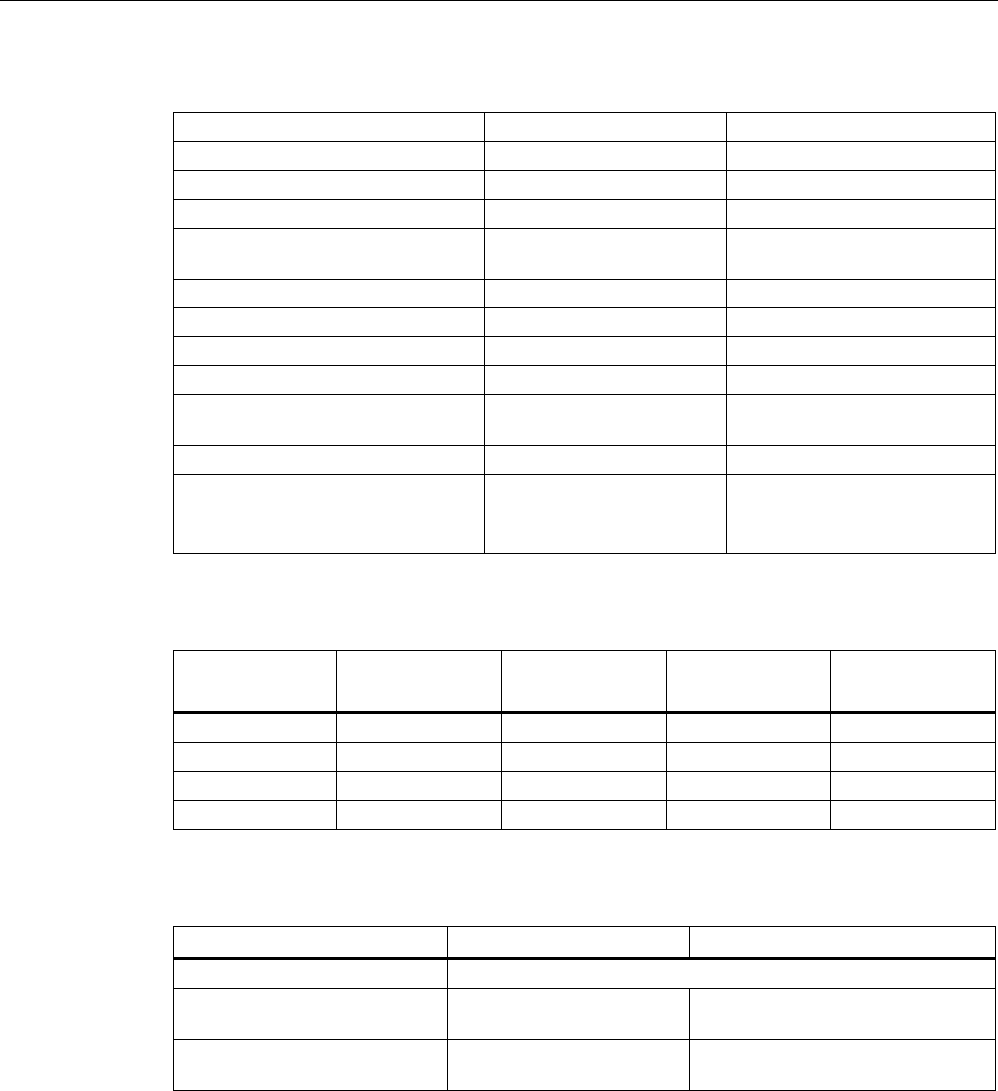
Accessories
10.1 Wide-range power supply unit for SIMATIC RF systems
SIMATIC RF600
398 System Manual, 05/2012, J31069-D0171-U001-A13-7618
Table 10- 3 Technical specifications of the output
Output voltage tolerance ∆Uout U
in = 230 VAC U
out nom ≤ +2 %/-1 %
Overvoltage protection Uout nom +20 % typ.
Noise ∆ULF U
in = min., BW: 1 MHz ≤ 1 % Uout
Noise ∆UHF U
in = min., BW: 20 MHz ≤ 2 % Uout
Line Regulation
Load Regulation
Uin = min./max.
Iout = 10...90...10 %
≤ 1,0 %
≤ 1,0 %
Short-circuit current Imax I
nom = 4 A (+50°C) 105 ... 130 % Inom
Settling time tR load variations Iout = 10...90...10 % < 5 ms
Temperature coefficient ε TA = -25 °C to +70 °C 0.01 %/K
Overload behavior Pover Constant current
Short-circuit protection/
No-load response
Continuous/no-load stability
Derating TA > +50 °C to +70 °C max. 2 %/K
Connector type Flanged connector
Binder,
Order no.: 09-3431-90-04
4 pins
Table 10- 4 Output configurations
Input Outputs
U1 = U2
ILoad =
I1 + I2
Efficiency
(%)
Remarks
110 VAC 24 VDC 0 A No-load stability
110 VAC 24 VDC 3 A ≥ 88
220 VAC 24 VDC 0 A No-load stability
220 VAC 24 VDC 3 A ≥ 90
Table 10- 5 Compliance with standards
Designation Standard Values
Electrical safety EN 60950 / UL 60950 / CAN/CSA 22.2 950, 3 Edition
Conducted interference EN 61000-6-3
EN 55011
Class B
Emission EN 61000-6-3
EN 55011
Class B
All values are measured at full-load and at an ambient temperature of 25 °C (unless
specified otherwise).
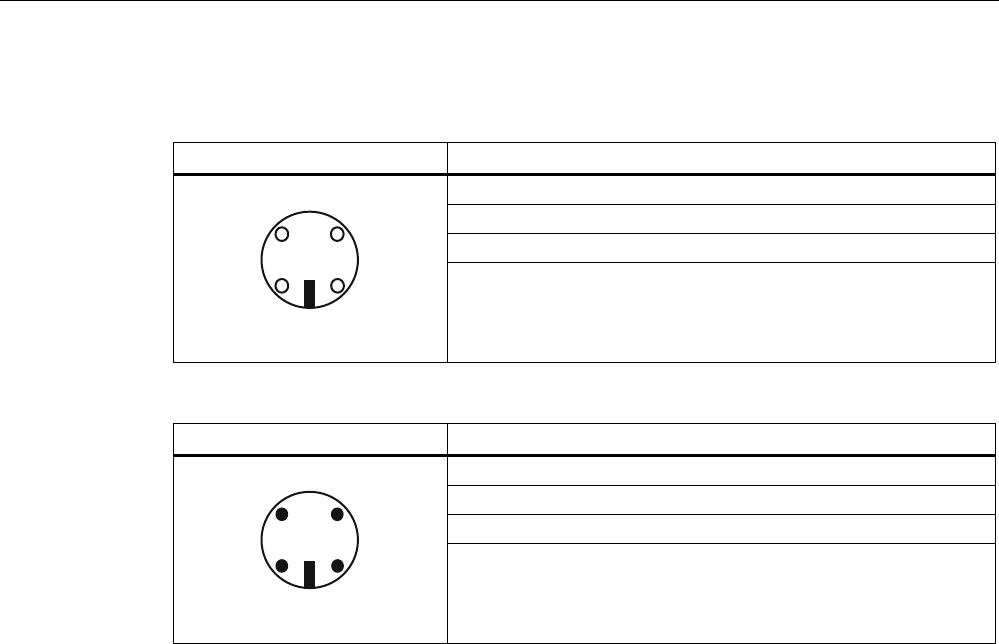
Accessories
10.1 Wide-range power supply unit for SIMATIC RF systems
SIMATIC RF600
System Manual, 05/2012, J31069-D0171-U001-A13-7618 399
10.1.7 Pin assignment of DC outputs and mains connection
DC outputs Assignment
(1) Ground (0V)
(2) +24 V DC
(3) +24 V DC
(4) Ground (0V)
Mains connection Assignment
(1) 100 to 240 V AC
(2) n.c.
(3) 100 to 240 V AC
(4) n.c.
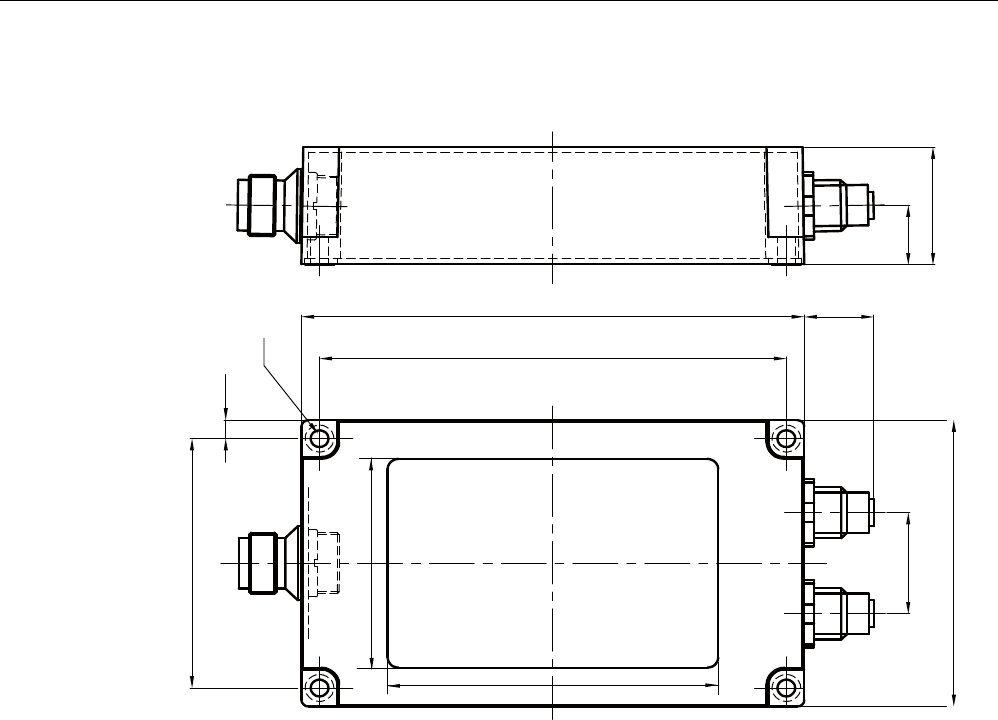
Accessories
10.1 Wide-range power supply unit for SIMATIC RF systems
SIMATIC RF600
400 System Manual, 05/2012, J31069-D0171-U001-A13-7618
10.1.8 Dimension drawing
s
s
s
Units of measurement:
All dimensions in mm
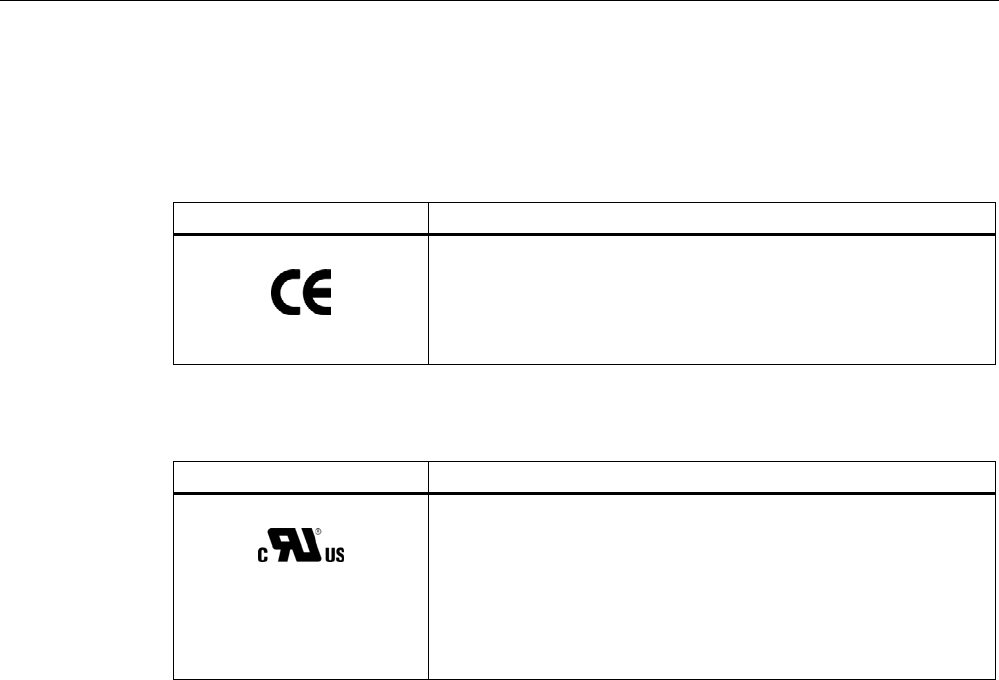
Accessories
10.1 Wide-range power supply unit for SIMATIC RF systems
SIMATIC RF600
System Manual, 05/2012, J31069-D0171-U001-A13-7618 401
10.1.9 Certificates and approvals
Table 10- 6 Wide-range power supply unit for SIMATIC RF systems 6GT2898-0AA00 - Europe,
6GT2898-0AA10 - UK
Certificate Description
CE approval to
2004/108/EC EMC
73/23/EEC LVD
Table 10- 7 Wide-range power supply unit for SIMATIC RF systems 6GT2898-0AA20 - USA
Standard
This product is UL-certified for the US and Canada.
It meets the following safety standards:
UL 60950-1 - Information Technology Equipment Safety - Part 1:
General Requirements
CSA C22.2 No. 60950 -1 - Safety of Information Technology
Equipment
UL Report E 205089

Accessories
10.1 Wide-range power supply unit for SIMATIC RF systems
SIMATIC RF600
402 System Manual, 05/2012, J31069-D0171-U001-A13-7618
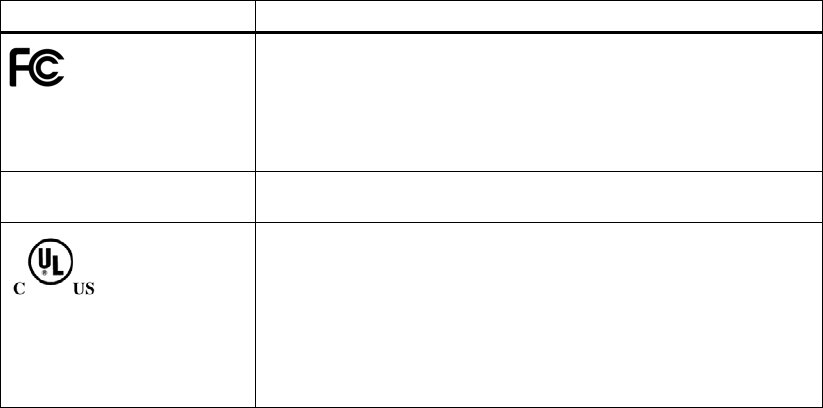
SIMATIC RF600
System Manual, 05/2012, J31069-D0171-U001-A13-7618 403
Appendix A
A.1 Certificates and approvals
Notes on CE marking
The following applies to the system described in this documentation:
The CE marking on a device is indicative of the corresponding approval:
DIN ISO 9001 certificate
The quality assurance system for the entire product process (development, production, and
marketing) at Siemens fulfills the requirements of ISO 9001 (corresponds to EN29001:
1987).
This has been certified by DQS (the German society for the certification of quality
management systems).
EQ-Net certificate no.: 1323-01
Table A- 1 FCC IDs: NXW-RF660, NXW-RF620R, NXW-RF630R, IC: 267X-RF620R, IC: 267X-
RF630
Standards
Federal Communications
Commission
FCC Title 47, Part 15.sections 15.247
Radio Frequency Interference Statement
This equipment has been tested and found to comply with the limits
for a Class A digital device, pursuant to Part 15 of the FCC Rules.
Industry Canada Radio
Standards Specifications
RSS-210 Issue 6, Sections 2.2, A8
This product is UL-certified for the USA and Canada.
It meets the following safety standard(s):
UL 60950-1 - Information Technology Equipment Safety - Part 1:
General Requirements
CSA C22.2 No. 60950 -1 - Safety of Information Technology
Equipment
UL Report E 205089
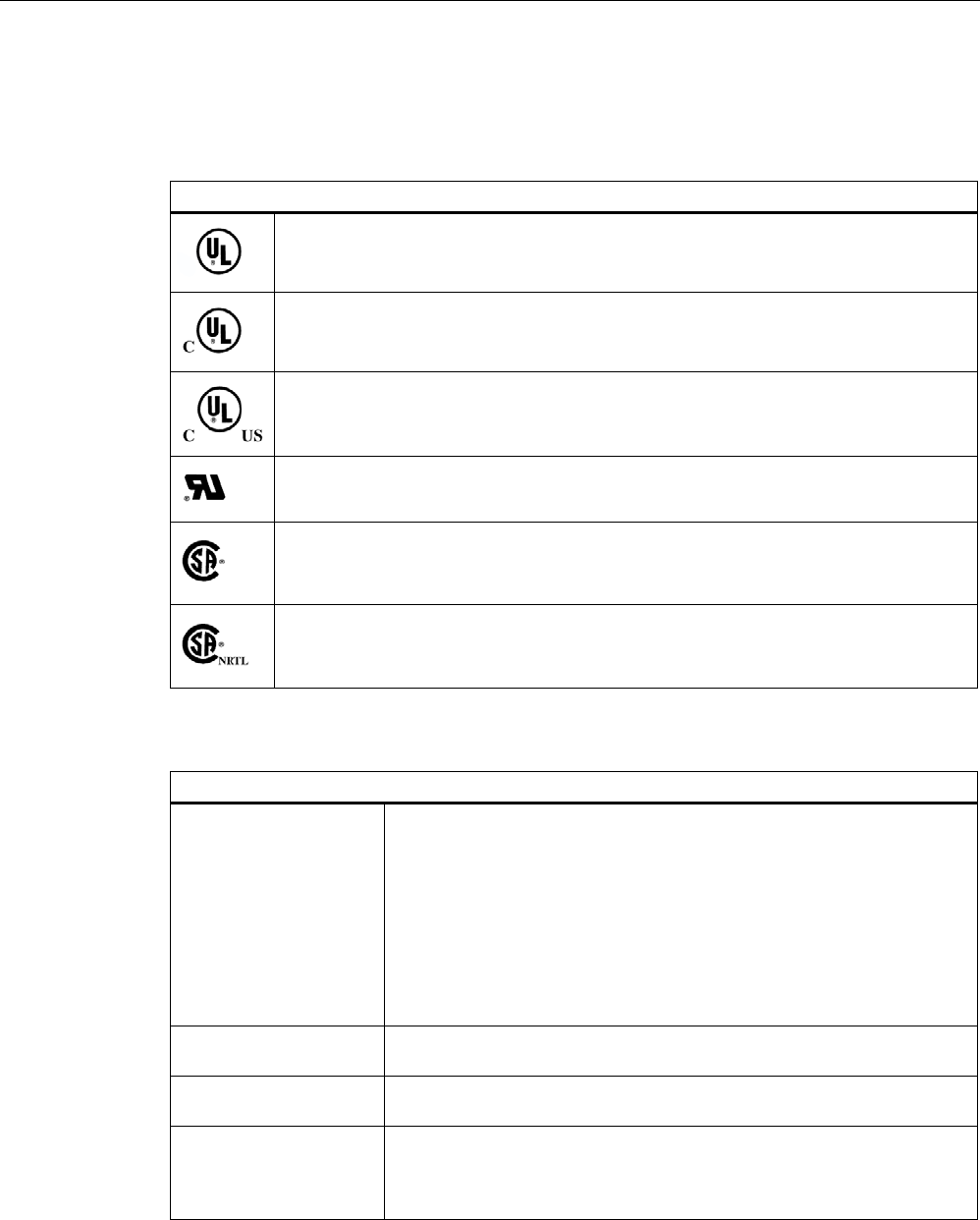
Appendix
A.1 Certificates and approvals
SIMATIC RF600
404 System Manual, 05/2012, J31069-D0171-U001-A13-7618
Certification for the USA, Canada and Australia
Safety
One of the following markings on a device is indicative of the corresponding approval:
Underwriters Laboratories (UL) to UL 60950 Standard (I.T.E), or to UL508
(IND.CONT.EQ)
Underwriters Laboratories (UL) according to Canadian standard C22.2 No. 60950
(I.T.E) or C22.2 No. 142 (IND.CONT.EQ)
Underwriters Laboratories (UL) according to standard UL 60950, Report E11 5352 and
Canadian standard C22.2 No. 60950 (I.T.E) or UL508 and C22.2 No. 142
(IND.CONT.EQ)
UL recognition mark
Canadian Standard Association (CSA) per Standard C22.2. No. 60950 (LR 81690) or
per C22.2 No. 142 (LR 63533)
Canadian Standard Association (CSA) per American Standard UL 60950 (LR 81690) or
per UL 508 (LR 63533)
EMC
USA
Federal Communications
Commission
Radio Frequency
Interference Statement
This equipment has been tested and found to comply with the limits for a
Class A digital device, pursuant to Part 15 of the FCC Rules. These limits
are designed to provide reasonable protection against harmful
interference when the equipment is operated in a commercial
environment. This equipment generates, uses, and can radiate radio
frequency energy and, if not installed and used in accordance with the
instruction manual, may cause harmful interference to radio
communications. Operation of this equipment in a residential area is likely
to cause harmful interference in which case the user will be required to
correct the interference at his own expense.
Shielded Cables Shielded cables must be used with this equipment to maintain compliance
with FCC regulations.
Modifications Changes or modifications not expressly approved by the manufacturer
could void the user’s authority to operate the equipment.
Conditions of Operations This device complies with Part 15 of the FCC Rules. Operation is subject
to the following two conditions: (1) this device may not cause harmful
interference, and (2) this device must accept any interference received,
including interference that may cause undesired operation.
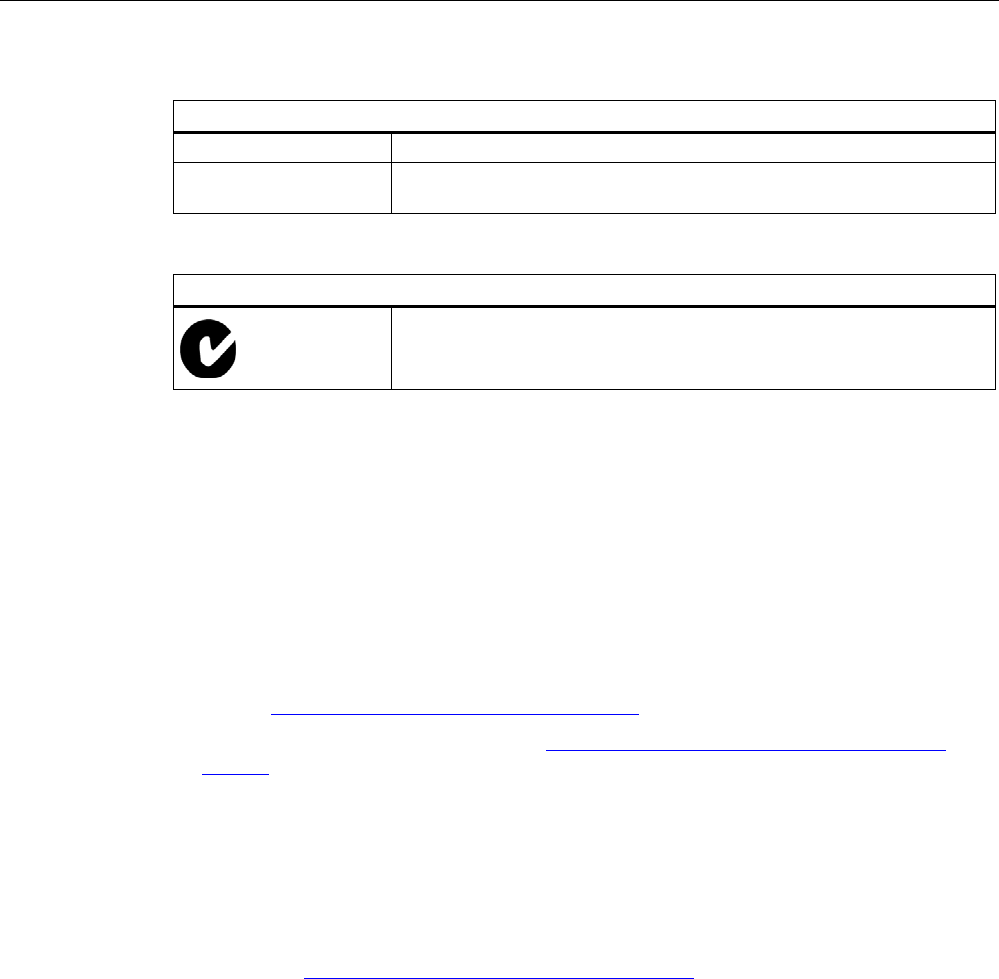
Appendix
A.2 Service & support
SIMATIC RF600
System Manual, 05/2012, J31069-D0171-U001-A13-7618 405
CANADA
Canadian Notice This Class B digital apparatus complies with Canadian ICES-003.
Avis Canadien Cet appareil numérique de la classe b est conforme à la norme NMB-003
du Canada.
AUSTRALIA
This product meets the requirements of the AS/NZS 3548 Norm.
A.2 Service & support
Technical Support
You can access technical support for all IA/DT projects via the following:
● Phone: + 49 (0) 911 895 7222
● Fax: + 49 (0) 911 895 7223
● E-mail (mailto:support.automation@siemens.com)
● Internet: Online support request form: (http://www.siemens.com/automation/support-
request)
Contact partner
If you have any further questions on the use of our products, please contact one of our
representatives at your local Siemens office.
The addresses are found on the following pages:
● In Internet (http://www.siemens.com/automation/partner)
● In Catalog CA 01
● In Catalog ID 10 specifically for industrial communication / industrial identification systems

Appendix
A.2 Service & support
SIMATIC RF600
406 System Manual, 05/2012, J31069-D0171-U001-A13-7618
Service & support for industrial automation and drive technologies
You can find various services on the Support homepage
(http://www.siemens.com/automation/service&support) of IA/DT on the Internet.
There you will find the following information, for example:
● Our newsletter containing up-to-date information on your products.
● Relevant documentation for your application, which you can access via the search
function in "Product Support".
● A forum for global information exchange by users and specialists.
● Your local contact for IA/DT on site.
● Information about on-site service, repairs, and spare parts. Much more can be found
under "Our service offer".
RFID homepage
For general information about our identification systems, visit RFID homepage
(http://www.siemens.com/ident).
Technical documentation on the Internet
A guide to the technical documentation for the various products and systems is available on
the Internet:
SIMATIC Guide manuals (http://www.siemens.com/simatic-tech-doku-portal)
Online catalog and ordering system
The online catalog and the online ordering system can also be found on the Industry Mall
Homepage (http://www.siemens.com/industrymall).
Training center
We offer appropriate courses to get you started. Please contact your local training center or
the central training center in
D-90327 Nuremberg.
Phone: +49 (0) 180 523 56 11
(€ 0.14 /min. from the German landline network, deviating mobile communications prices are
possible)
For information about courses, see the SITRAIN homepage (http://www.sitrain.com).
SIMATIC RF600
System Manual, 05/2012, J31069-D0171-U001-A13-7618 407
Glossary
Active field
Area with minimum field strength containing the sensing range. Within this sensing range,
data can be read from the tag or written to the tag.
Active surface
See active field
See active field
Active surface
See active field
See active field
Active tag/transponder
Active transponders are battery-operated, i.e. they obtain the energy required to save data
on the microchip from a built-in battery. They are usually in an idle state and do not transmit
data in order to increase the energy source's service life. The transmitter is only activated
when it receives a special activation signal.
AM
Amplitude modulation; data are present in the changes in carrier frequency amplitude.
Amplitude modulation
See AM
AS
See Automation system
ASM
Interface module, see Communication modules
Automation system (AS)
A programmable logical controller (PLC) of the SIMATIC S7 system, comprising a central
controller, a CPU and various I/O modules.

Glossary
SIMATIC RF600
408 System Manual, 05/2012, J31069-D0171-U001-A13-7618
Battery-free data storage unit
Mobile data storage units which operate without batteries. (See transponder). Power is
supplied to the data storage unit across an electromagnetic alternating field.
Baud
Unit (digits per second).
Baud rate
The baud rate describes the data transmission's digit rate.
Byte
A group of eight bits
CE guidelines
See CE Label
CE Label
Communauté Européenne (product mark of the European Union)
Communication modules
Communication modules are used to integrate the identification systems in SIMATIC or
SINUMERIK systems, or to connect them to PROFIBUS, PROFINET, PC or any other
system. Once supplied with the corresponding parameters and data, they handle data
communication. They then make the corresponding results and data available. Suitable
software blocks (FB/FC for SIMATIC; C libraries for PCs with Windows) ensure easy and
fast integration in the application.
Continuous Wave
See CW
CW
Continuous Wave; data are present in the carrier frequency which is switched on and off.
Data rate
The rate at which data are exchanged between the tag and reader. Typical units are bits per
second or bytes per second.

Glossary
SIMATIC RF600
System Manual, 05/2012, J31069-D0171-U001-A13-7618 409
Data transfer rate
Number of characters which can be transmitted from a tag to a reader within a defined time.
Baud rates are also used to specify how fast a reader can read information.
Data transmission rate
Unit of measurement for the volume of data transmitted within a unit of time, e.g. bytes/s,
see also Baud
dB
See Decibel
dBm
Dimensional unit for the transmitted power in the logarithmic relation to 1 mW (Milliwatt).
0dBm = 1mW, +23dBm = 200mW, +30dBm = 1W.
dBr
dB(relative); a relative difference to a reference value
Decibel (dB)
Unit of measurement for the logarithmic relationship between two variables.
Dense Reader Mode (DRM)
In this mode, tag readability is increased through the application of interference-reducing
measures.
DRM is only defined for Gen 2 and does not function with other tag types.
Detuning
UHF antennas are tuned to receive a particular electromagnetic wavelength from the reader.
If the antenna is too close to metal or a metallic material, it can be detuned, making the
performance deteriorate.
Distant field communication
RFID antennas emit electromagnetic waves. If a tag is more than a full wavelength away
from the reader's transmitting antenna, it is in a "distant field". If it is within a full wavelength,
this is known as the "near field".
The wavelength of UHF-RFID systems is approx. 33 cm.

Glossary
SIMATIC RF600
410 System Manual, 05/2012, J31069-D0171-U001-A13-7618
The distant field signal is attenuated with the square of the distance from the antenna,
whereas the near field signal is attenuated with the cube of the distance from the antenna.
Passive RFID systems based on distant field communication (UHF and microwave systems)
have a greater read range than systems based on near field communication (typically low-
frequency and high-frequency systems).
Dwell time
The dwell time is the time in which the transponder dwells within the sensing range of a
reader. The reader can exchange data with the transponder during this time.
Dynamic mode
In dynamic mode, the data carrier moves past the reader at a traversing rate which depends
on the configuration. Various checking mechanisms ensure error-free data transfer even
under extreme environmental conditions.
EAN
European article number. Standardized barcode used in Europe, Asia and South America. Is
administered by EAN International.
EBS
Equipotential Bonding Strip
Effective Isotropic Radiated Power
See EIRP
Effective Radiated Power
See ERP.
EIRP
Effective Isotropic Radiated Power; unit of measurement for the transmission power of
antennas (referred to an isotropic radiator) mainly used in the USA. EIRP is specified in
Watt, and is not equal to ERP. (0dbi = - 2.14 dBm)
Electromagnetic compatibility (EMC)
Electromagnetic compatibility is the ability of an electrical or electronic device to operate
satisfactorily in an electromagnetic environment without affecting or interfering with the
environment over and above certain limits.

Glossary
SIMATIC RF600
System Manual, 05/2012, J31069-D0171-U001-A13-7618 411
EMC
See Electromagnetic compatibility
EMC directive
Guidelines for electromagnetic compatibility This guideline relates to any electrical or
electronic equipment, plant or system containing electric or electronic components.
EPC
See EPC global
EPC global
Electronic Product Code. Standardized number system for identifying articles with a data
width of either 64, 96 or 256 bits.
Equipotential bonding
Potential differences between different parts of a plant can arise due to the different design
of the plant components and different voltage levels. It is necessary to compensate for these
differences by equipotential bonding: this is done by combining the equipotential bonding
conductors of power components and
non-power components on a centralized equalizing conductor (EBS = Equipotential Bonding
Strip).
ERP
Effective Radiated Power; unit of measurement for the transmission power of antennas
(referred to an ideal dipole) mainly used in Europe. ERP is specified in Watt, and is not equal
to EIRP. (0dbm = + 2.14 dBi)
ESD directive
Directive for handling Electrostatic Sensitive Devices
ETSI
European Telecommunications Standard Institute
European Article Numbering
See EAN.
eXtensible markup language
See XML.

Glossary
SIMATIC RF600
412 System Manual, 05/2012, J31069-D0171-U001-A13-7618
FCC
Federal Communications Commission (USA)
FHSS
Frequency Hopping Spread Spectrum; frequency change procedure.
FM
Frequency modulation; data are present in the changes in the frequency of the carrier
frequency.
Frequency hopping
Frequency hopping technique Automatic search for free channels.
In frequency hopping, data packets are transferred between the communication partners on
constantly changing carrier frequencies. This makes it possible to react to interference from
devices transmitting signals in the same frequency range (channel). If an attempt to send a
data packet is unsuccessful, the packet can be transmitted again on a different carrier
frequency. By default the RF600 uses this procedure (FCC) only in the USA and Canada.
Frequency modulation
See FM.
Frequency Shift Keying
See FSK
FSK
Modulation, Frequency Shift Keying; data are present in the changes between two
frequencies.
ICNIRP
International Commission of Non Ionizing Radiological Protection
ICRP
International Commission of Radiological Protection
Interface modules
See communication modules

Glossary
SIMATIC RF600
System Manual, 05/2012, J31069-D0171-U001-A13-7618 413
Interrogator
See readers
ISO
International Standard Organization
ISO 18000
Standard for data exchange of RFID systems between reader and transponder. There are
various subdefinitions of this standard for the various approved frequency ranges for RFID.
For example, the range 865 ... 868 MHz is described in ISO 18000-6.
LAN
Local Area Network
LBT
Listen Before Talk; the reader only transmits when the channel is free.
License plate
10-digit code that is saved on every RFID tag. The code of the license plate establishes a
connection between the item of baggage and the baggage processing system of the airport.
As soon as the license plate has been read by the reader, a message is automatically sent
to the baggage processing system. This message contains important data regarding the
flight and destination of the item of baggage. Using this data, the item of baggage can be
successfully sorted by the baggage processing system of the airport.
Limit distance
The limit distance is the maximum clear distance between reader antenna and transponder
at which the transmission can still function under normal conditions.
Mass recording
The capability of a reader to record several or many transponders quasi-simultaneously and
to read the code. Contrary to the multi-tag capability, the reader is not able to specifically
address individual tags.
MDS
Mobile data memory, see Transponder.

Glossary
SIMATIC RF600
414 System Manual, 05/2012, J31069-D0171-U001-A13-7618
MES
Manufacturing Execution System
Metal-free area
Distance/area which must be maintained between the transponder and metal in order to
prevent interference during data transfer between the transponder and reader.
Mobile Data Memory (MDS)
Mobile data memory, see Transponder
Modulation
Modulation is a procedure with which one or more characteristics (e.g. phase, amplitude,
frequency) of a carrier oscillation are modified according to the response of a modulating
oscillation.
Multi-tag capability
Multi-tag capability means that a reader can communicate simultaneously with different data
carriers. Therefore the reader can specifically address a transponder with its UID (see also
mass recording).
Near field communication
RFID antennas emit electromagnetic waves. If a tag is more than a full wavelength away
from the reader's transmitting antenna, it is in a "distant field". If it is within a full wavelength,
this is known as the "near field".
The wavelength of UHF-RFID systems is approx. 33 cm.
The distant field signal is attenuated with the square of the distance from the antenna,
whereas the near field signal is attenuated with the cube of the distance from the antenna.
Passive RFID systems based on near field communication (typically low-frequency and high-
frequency systems) have a greater read range than systems based on distant field
communication (typically UHF and microwave systems).
Passive tag
If electromagnetic waves from the reader reach the tag antenna, the energy is converted by
the antenna into electricity which provides the tag chip with current. The tag is able to return
information stored on the chip. Passive tags do not usually have a battery. A battery is
required if the tag has a RAM, but the battery is only used to save information in the RAM. In
particular, the battery is not used for data exchange between reader and transponder.

Glossary
SIMATIC RF600
System Manual, 05/2012, J31069-D0171-U001-A13-7618 415
Passive tag/transponder
A tag without its own power supply. Passive transponders obtain the energy required to
supply the microchips from the radio waves they receive.
PDM
Pulse duration modulation; data are present in the pulse duration.
Phase modulation
See PM
PLC
Programmable Logic Controller, see PLC.
Programmable logic controller; electronic device used in automation engineering for open-
loop and closed-loop control tasks. The typical modules of a PLC are the CPU, power supply
(PS) and various input/output modules (I/O).
Programmable controller: The programmable logical controllers (PLC) of the SIMATIC S5
system consist of a central controller, one or more CPUs, and various other modules (e.g.
I/O modules).
PLC
Programmable Logic Controller, see PLC.
Programmable logic controller; electronic device used in automation engineering for open-
loop and closed-loop control tasks. The typical modules of a PLC are the CPU, power supply
(PS) and various input/output modules (I/O).
Programmable controller: The programmable logical controllers (PLC) of the SIMATIC S5
system consist of a central controller, one or more CPUs, and various other modules (e.g.
I/O modules).
PLC
Programmable Logic Controller, see PLC.
Programmable logic controller; electronic device used in automation engineering for open-
loop and closed-loop control tasks. The typical modules of a PLC are the CPU, power supply
(PS) and various input/output modules (I/O).
Programmable controller: The programmable logical controllers (PLC) of the SIMATIC S5
system consist of a central controller, one or more CPUs, and various other modules (e.g.
I/O modules).
PM
Phase modulation; data are present in the changes in carrier frequency phase.

Glossary
SIMATIC RF600
416 System Manual, 05/2012, J31069-D0171-U001-A13-7618
Programmable Logic Controller
See PLC.
Programmable Logic Controllers
See PLC
Protocol
A combination of rules which manage communications systems.
Pulse duration modulation
See PDM
Radio Frequency Identification
See RFID.
Read rate
Number of tags which can be read within a defined time.
The read rate can also be used for the maximum rate at which data can be read from a tag.
The unit is bits per second or bytes per second.
Reader (also interrogator)
Readers transfer data between mobile data memories (transponders) and the higher-level
systems. The data, including the energy required for processing and sending back, are
transmitted to the transponder across an electromagnetic alternating field. This principle
enables contact-free data transmission, ensures high industrial compatibility and works
reliably in the presence of contamination or through non-metallic materials.
Reader talks first
A passive tag communicates in the read field of a reader with the reader. The reader sends
energy to the tags which only reply when they are explicitly requested. The reader is able to
find tags with a specific serial number commencing with either 1 or 0.
If more than one tag responds, the reader can scan all tags commencing with 01 and
subsequently with 010. This is referred to as "walking" on a binary tree, or "tree walking".
Reading range
The distance within which a reader can communicate with a tag. Active tags can cover a
greater distance than passive tags because they use a battery to send signals.

Glossary
SIMATIC RF600
System Manual, 05/2012, J31069-D0171-U001-A13-7618 417
Reciprocity
Reciprocity means that a two-way relationship exists between the transmit and receive case
of a passive antenna.
RFID
Radio Frequency Identification; a method of identifying items using electromagnetic waves.
The reader supplies energy to the tag and communicates with it.
RFID systems
SIMATIC RF identification systems control and optimize material flow and production
sequences. They identify reliably, quickly and economically, use non-contact data
communication technology, and store data directly on the product. They are also resistant to
contamination.
RH circular
Right hand circular polarization
RSSI threshold value
The "Received Signal Strength Indication" (RSSI) is an indicator of the receive field strength
of the transponders. When the field strength with which the transponder is received
undershoots the set RSSI threshold, the reader ignores the signal of this transponder.
The RSSI threshold value can be activated to limit areas of the antenna fields to those in
which transponders should still be accessed. This can be used to avoid undesirable effects,
such as range overshoot when reading transponder data.
RTNC
Connector designation (Reverse TNC). Industrial coaxial connector with screw coupling, can
be used for frequencies of up to 2 GHz. The mechanical design of the RTNC connector is
not compatible with the TNC connector.
RTTE
Radio and Telecommunications Terminal Equipment
SCM
Supply Chain Management

Glossary
SIMATIC RF600
418 System Manual, 05/2012, J31069-D0171-U001-A13-7618
Secondary fields
In addition to the main sensing range (antenna's main direction of transmission) there are
secondary fields. These secondary fields are usually smaller than the main fields. The shape
and characteristics of the secondary field depend on the metallic objects in the surroundings.
Secondary fields should not be used in configuring.
SELV
Safety Extra Low Voltage
Sensing range
Area in which reliable data exchange between transponder and reader is possible due to a
particular minimum field strength.
SSB
Single Sideband Modulation. SSB is similar to AM (amplitude modulation), however, only
one sideband is sent instead of two sidebands. This saves 50% of the spectrum required in
the HF channel without affecting the signal/data rate. For RFID applications, an HF carrier
must also be sent to supply energy to the tag. Sending a carrier is many times not required
for other SSB applications, since the HF carrier itself does not contain any data.
Static mode
In static mode the transponder is positioned at a fixed distance (maximum: limit distance)
exactly above the reader.
Tag
See transponder
Tag talks first
A passive tag communicates in the read field of a reader with the reader. When a tag
reaches the field of a reader, it immediately indicates its presence by reflecting a signal.
TARI
Abbreviation of Type A Reference Interval. Duration (period) for representation of a bit with
content 0.
TCP/IP
Transmission Control Protocol/Internet Protocol

Glossary
SIMATIC RF600
System Manual, 05/2012, J31069-D0171-U001-A13-7618 419
Telegram cycles
A passive tag communicates in the read field of a reader with the reader. When a tag
reaches the field of a reader, it immediately indicates its presence by reflecting a signal.
Transmission of a read or write command is implemented in three cycles. They are called
"Telegram cycles". One or two bytes of user data can be transferred with each command.
The acknowledgment or response transfer (status or read data) takes place in three further
cycles.
TNC
Connector designation (Threaded Neill Concelman).
Industrial coaxial connector with screw coupling, can be used for frequencies of up to 2 GHz.
Transceiver (transmitter/receiver)
Combination of transmitter and receiver. A unit which can both send and receive
electromagnetic waves.
Transmission distance
Distance between communication module and transponder
Transponder
An invented word from transmitter and responder. Transponders are used on the product,
the product carrier, the object, or its transport or packaging unit, and contain production and
manufacturing data, i.e. all application-specific data. They follow the product through
assembly lines, transfer and production lines and are used to control material flow.
Because of their wireless design, transponders can be used, if necessary, at individual work
locations or manufacturing stations, where their data can be read and updated.
Tree walking
See Reader talks first.
UHF
Ultra-high frequency; frequency range from 300 MHz to 3 GHz. UHF RFID tags usually
operate between 866 MHz and 960 MHz. This corresponds to a wavelength of approx. 33
cm.
UID
User IDentifier; the UID is an unambiguous number in the transponder, assigned by the
manufacturer. The UID is unambiguous, and can usually also be used as a fixed code. The
UID is used to specifically address a transponder

Glossary
SIMATIC RF600
420 System Manual, 05/2012, J31069-D0171-U001-A13-7618
Ultra High Frequency
See UHF.
User IDentifier
See UID
VESA
Video Electronics Standards Association (authority that defines standards for the PC
industry)
Walking
See Reader talks first.
WLAN
Wireless LAN
writer
See readers
Writing/reading range
See transmission distance
XML
eXtensible markup language; XML is a language derived from SGML with which other
languages (document types) can be described. In the meantime, XML is a widely used
language for distributing information on the Internet. Data exchange between reader and
read station is carried out using XML commands.
SIMATIC RF600
System Manual, 05/2012, J31069-D0171-U001-A13-7618 421
Index
A
Antenna cable
Connector type, 69
Antenna cables, 69
Bending radius, 69
Antenna configuration, 39
Antenna gain, 60
Cable loss 4 dB, 60
Dependency on plane, 61
FCC, 60
Frequency dependency, 61
Antenna mounting kit
RF620R, 108
RF640R, 153
RF670R, 174
Appearance of resonance, 68
B
Beam angle, 67
Read area, 67
Beam width
Definition, 65
ETSI, 65
Bending radius
Antenna cables, 69
C
Cable
Shielding, 89
Cable loss
Definition, 68
Dependencies, 68
Characteristic impedance
Definition, 68
Circular polarization, 63
Classes, 266
Coaxial antenna cables
Coaxial, 69
Configuration, 108, 124
Antennas, 39
Connector type, 69
R-TNC, 69
Thread, 69
Contact partner, 405
Coupling paths, 86
Courses, 406
D
Decibel
Calculation example, 59
Definition, 59
Reference variables, 60
Design of the RF640R reader, 133
Design of the RF670R reader, 162
Dimensions
RF620R reader, 113
RF630R reader, 129
RF670R reader, 179
Directional antennas, 57
E
EIRP, 58
Electromagnetic compatibility
Coupling paths, 86
Electromagnetic interference, 85
Electromagnetic waves
UHF range, 72
EMC Directives, 404
Propagation of electromagnetic interference, 85
EMC Guidelines
Avoiding interference, 87
Basic Rules, 83
Cable shielding, 90
Definition, 82
Equipotential bonding, 88
Overview, 82
Equipotential bonding, 88
ERP, 58
Cable loss, 58
Logarithmic, standardized, 58
F
Front-to-back ratio, 64
Functions
Overview, 185

Index
SIMATIC RF600
422 System Manual, 05/2012, J31069-D0171-U001-A13-7618
G
Gate configuration
Application areas, 41
Arrangement of antenna, 41
Generations, 266
I
Identification system
UHF range, 23
Impedance
Definition, 61
Specifications, 61
Influence of
Interference, 72
Liquids, 73
Metals, 72
Non-metallic substances, 73
reflections, 72
Influencing factors, 54
Interfaces, 108, 124
Digital, 137
RS422, 108
Interference, 72
Interference sources
Electromagnetic, 85
Isotropic radiator, 57
Isotropic spherical radiator, 60
L
Linear polarization, 64
M
Main applications
RF600, 25
RF620R, 25
RF630R, 25
RF640R, 25
RF680M, 25
RF-MANAGER, 25
Main beam direction, 64
Minimum spacing
For antennas, 45
Mounting of RF620R
Antenna mounting kit, 108
Mounting of RF670R
Antenna mounting kit, 174
Mounting types of the RF620R reader, 108
Mounting types of the RF630R reader, 124
O
Ordering data for RF670R, 163
Accessories, 164
Antennas and antenna cables, 164
Ordering data RF640R, 134
Accessories, 135
P
Parameter, 54
Polarization
Circular, 63
Linear, 64
Portal configuration
Application example, 39
Power supply
RF640R, 143
RF670R, 171
R
Reader RF680M
Features, 184
Functions, 185
Reading range
Dependency of the, 51
Reciprocity, 57
reflections, 72
Reflections, 68
Regulations for UHF frequency ranges
Europe, 74
India, 77
Russia, 78
Return loss
Definition, 62
RF600
Main applications, 25
RF620A
Technical specifications, 207
RF620R reader
Configuration, 108
Design, 94
Dimensions, 113
Interfaces, 108
Mounting types, 108
Status display, 97, 120
RF630R reader
Accessories, 118

Index
SIMATIC RF600
System Manual, 05/2012, J31069-D0171-U001-A13-7618 423
Configuration, 124
Design, 117
Dimensions, 129
Interfaces, 124
Mounting types, 124
RF640R reader
Design, 133
Digital I/O interface, 137
Interfaces, 137, 143
LEDs, 136
Mounting types, 153
Power supply, 143
RF660A
Technical specifications, 257
RF660A antenna
Radiation/reception characteristic for Europe
(ETSI), 255
Radiation/reception characteristic for USA
(FCC), 255
RF670R reader
CE Approval, 180
Design, 162
Digital I/O interface, 166
FCC information, 182
IC-FCB information, 183
Interfaces, 166, 171
LEDs, 165
Mounting types, 174
Power supply, 171
RF-MANAGER
Levels of the automation/IT structure, 23
S
Safety Information, 17
Scalar product, 57
Securing the RF640R
Antenna mounting kit, 153
Shielding, 90
Antenna cables, 69
Spurious lobes, 64
Status display of the RF620R reader, 97, 120
Structure of the RF620R reader, 94
Structure of the RF630R reader, 117
T
Tag standards, 184
Technical documentation
On the Internet, 406
Technical Support, 405
Training, 406
Transponder
Classes, 266
Generations, 266
Improving detection, 72
U
UHF band
China, 76
V
Voltage standing wave ratio
Definition, 62
VSWR
Definition, 62

www.siemens.com/automation
Subject to change
J31069-D0171-U001-A13-7618
© Siemens AG 2012
SIEMENS AG
Industry Sector
Sensors and Communication
Postfach 4848
90026 NÜRNBERG
DEUTSCHLAND
www.siemens.com/ident
Get more information